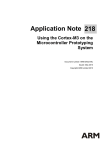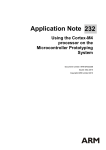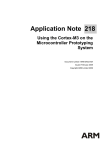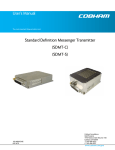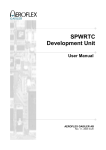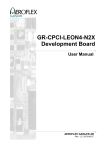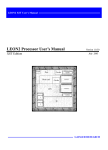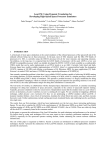Download GRSIM User`s Manual
Transcript
GRSIM User’s Manual for version 1.1.54, 16 October 2015 This manual is for GRSIM (version 1.1.54, 16 October 2015), which is a simulator developed at Cobham Gaisler AB. c 2015 Cobham Gaisler AB. Copyright Permission is granted to make and distribute verbatim copies of this manual provided the copyright notice and this permission notice are preserved on all copies. Permission is granted to copy and distribute modified versions of this manual under the conditions for verbatim copying, provided also that the entire resulting derived work is distributed under the terms of a permission notice identical to this one. Permission is granted to copy and distribute translations of this manual into another language, under the above conditions for modified versions. Cobham Gaisler AB i GRSIM User’s Manual Short Contents 1 2 3 4 A B C D Introduction . . . . . . . . . . . . . . . . . . . . . . . . . . . . . . . . . . . . . . . . . . . . . . . 1 Operation . . . . . . . . . . . . . . . . . . . . . . . . . . . . . . . . . . . . . . . . . . . . . . . . . 3 Simulator Modules . . . . . . . . . . . . . . . . . . . . . . . . . . . . . . . . . . . . . . . . . . 21 Library . . . . . . . . . . . . . . . . . . . . . . . . . . . . . . . . . . . . . . . . . . . . . . . . . . 41 HASP . . . . . . . . . . . . . . . . . . . . . . . . . . . . . . . . . . . . . . . . . . . . . . . . . . . 45 Sample simulator configuration . . . . . . . . . . . . . . . . . . . . . . . . . . . . . . . . . . 47 Simple Example Amba Device . . . . . . . . . . . . . . . . . . . . . . . . . . . . . . . . . . 53 grcommon.h . . . . . . . . . . . . . . . . . . . . . . . . . . . . . . . . . . . . . . . . . . . . . . 57 GRSIM User’s Manual ii Cobham Gaisler AB Cobham Gaisler AB iii GRSIM User’s Manual Table of Contents 1 Introduction . . . . . . . . . . . . . . . . . . . . . . . . . . . . . . . . . . . . . . . . . . . 1 1.1 1.2 1.3 1.4 1.5 1.6 2 Supported platforms and system requirements . . . . . . . . . . . . . . . . . . . . . . . . . . . . . . . . . . . Obtaining GRSIM . . . . . . . . . . . . . . . . . . . . . . . . . . . . . . . . . . . . . . . . . . . . . . . . . . . . . . . . . . . . . Installation . . . . . . . . . . . . . . . . . . . . . . . . . . . . . . . . . . . . . . . . . . . . . . . . . . . . . . . . . . . . . . . . . . . License installation . . . . . . . . . . . . . . . . . . . . . . . . . . . . . . . . . . . . . . . . . . . . . . . . . . . . . . . . . . . . Problem reports . . . . . . . . . . . . . . . . . . . . . . . . . . . . . . . . . . . . . . . . . . . . . . . . . . . . . . . . . . . . . . . Limitations to the evaluation version . . . . . . . . . . . . . . . . . . . . . . . . . . . . . . . . . . . . . . . . . . . . 1 1 1 1 1 1 Operation. . . . . . . . . . . . . . . . . . . . . . . . . . . . . . . . . . . . . . . . . . . . . . 3 2.1 2.2 Operational modes . . . . . . . . . . . . . . . . . . . . . . . . . . . . . . . . . . . . . . . . . . . . . . . . . . . . . . . . . . . . 3 Command line options . . . . . . . . . . . . . . . . . . . . . . . . . . . . . . . . . . . . . . . . . . . . . . . . . . . . . . . . . 3 2.2.1 Switches specific to certain modules . . . . . . . . . . . . . . . . . . . . . . . . . . . . . . . . . . . . . . . . 3 2.2.2 (VENDOR GAISLER) . . . . . . . . . . . . . . . . . . . . . . . . . . . . . . . . . . . . . . . . . . . . . . . . . . . . 4 2.2.2.1 (GAISLER APBUART) GRLIB APB UART . . . . . . . . . . . . . . . . . . . . . . . . . . . 4 2.2.2.2 (GAISLER ETHMAC) GRLIB GRETH 10/100 Ethernet MAC . . . . . . . . . . 4 2.2.2.3 (GAISLER GPTIMER) GRLIB APB General Purpose Timer . . . . . . . . . . . 4 2.2.2.4 (GAISLER GRGPIO) General Purpose I/O Port . . . . . . . . . . . . . . . . . . . . . . . 4 2.2.2.5 (GAISLER IRQMP) Multiprocessor Interrupt controller options . . . . . . . . . 5 2.2.2.6 (GAISLER L2C) LEON2 Compatibility, UART . . . . . . . . . . . . . . . . . . . . . . . . 5 2.2.2.7 (GAISLER LEON3|4) LEON3|4 CPU . . . . . . . . . . . . . . . . . . . . . . . . . . . . . . . . 5 2.2.2.8 (GAISLER SDCTRL) GRLIB SDRAM Controller . . . . . . . . . . . . . . . . . . . . . . 6 2.2.2.9 (GAISLER SPW) GRLIB GRSPW SpaceWire controller . . . . . . . . . . . . . . . . 6 2.2.2.10 (GAISLER SPW2) GRLIB GRSPW2 SpaceWire controller . . . . . . . . . . . . . 6 2.2.2.11 (GAISLER SRCTRL) GRLIB SRAM/PROM Controller . . . . . . . . . . . . . . . 7 2.2.2.12 (GAISLER PCIFBRG) GRLIB GRPCI PCI master/target interface . . . . 7 2.2.3 (VENDOR ESA) . . . . . . . . . . . . . . . . . . . . . . . . . . . . . . . . . . . . . . . . . . . . . . . . . . . . . . . . . 7 2.2.3.1 (ESA LEON2) Leon2 CPU . . . . . . . . . . . . . . . . . . . . . . . . . . . . . . . . . . . . . . . . . . . 8 2.2.3.2 (ESA MCTRL) Leon2 Memory Controller. . . . . . . . . . . . . . . . . . . . . . . . . . . . . . 8 2.3 Interactive Commands . . . . . . . . . . . . . . . . . . . . . . . . . . . . . . . . . . . . . . . . . . . . . . . . . . . . . . . . . 9 2.4 Simulator configuration . . . . . . . . . . . . . . . . . . . . . . . . . . . . . . . . . . . . . . . . . . . . . . . . . . . . . . . 10 2.4.1 Constructing a simulator configuration . . . . . . . . . . . . . . . . . . . . . . . . . . . . . . . . . . . . 10 2.5 Running applications . . . . . . . . . . . . . . . . . . . . . . . . . . . . . . . . . . . . . . . . . . . . . . . . . . . . . . . . . 12 2.6 Inserting breakpoints and watchpoints . . . . . . . . . . . . . . . . . . . . . . . . . . . . . . . . . . . . . . . . . 13 2.7 Displaying registers . . . . . . . . . . . . . . . . . . . . . . . . . . . . . . . . . . . . . . . . . . . . . . . . . . . . . . . . . . . 14 2.8 Code coverage. . . . . . . . . . . . . . . . . . . . . . . . . . . . . . . . . . . . . . . . . . . . . . . . . . . . . . . . . . . . . . . . 14 2.9 Symbolic debug information and profiling . . . . . . . . . . . . . . . . . . . . . . . . . . . . . . . . . . . . . . 15 2.10 Displaying memory contents. . . . . . . . . . . . . . . . . . . . . . . . . . . . . . . . . . . . . . . . . . . . . . . . . . 16 2.11 Disassembly of memory . . . . . . . . . . . . . . . . . . . . . . . . . . . . . . . . . . . . . . . . . . . . . . . . . . . . . . 17 2.12 Loadable command module . . . . . . . . . . . . . . . . . . . . . . . . . . . . . . . . . . . . . . . . . . . . . . . . . . 17 2.13 GDB interface . . . . . . . . . . . . . . . . . . . . . . . . . . . . . . . . . . . . . . . . . . . . . . . . . . . . . . . . . . . . . . 18 2.13.1 Attaching to gdb . . . . . . . . . . . . . . . . . . . . . . . . . . . . . . . . . . . . . . . . . . . . . . . . . . . . . . . 18 2.13.2 Debugging of applications . . . . . . . . . . . . . . . . . . . . . . . . . . . . . . . . . . . . . . . . . . . . . . . 19 2.13.3 Detaching . . . . . . . . . . . . . . . . . . . . . . . . . . . . . . . . . . . . . . . . . . . . . . . . . . . . . . . . . . . . . . 19 2.13.4 Specific GDB optimization . . . . . . . . . . . . . . . . . . . . . . . . . . . . . . . . . . . . . . . . . . . . . . 20 2.13.5 Limitations of gdb interface. . . . . . . . . . . . . . . . . . . . . . . . . . . . . . . . . . . . . . . . . . . . . . 20 GRSIM User’s Manual 3 iv Cobham Gaisler AB Simulator Modules . . . . . . . . . . . . . . . . . . . . . . . . . . . . . . . . . . . . 21 3.1 3.2 The basic structure . . . . . . . . . . . . . . . . . . . . . . . . . . . . . . . . . . . . . . . . . . . . . . . . . . . . . . . . . . . Read and Write operations . . . . . . . . . . . . . . . . . . . . . . . . . . . . . . . . . . . . . . . . . . . . . . . . . . . . 3.2.1 The parameters explained . . . . . . . . . . . . . . . . . . . . . . . . . . . . . . . . . . . . . . . . . . . . . . . . 3.2.2 Ordinary accesses . . . . . . . . . . . . . . . . . . . . . . . . . . . . . . . . . . . . . . . . . . . . . . . . . . . . . . . . 3.2.3 Diagnostic accesses. . . . . . . . . . . . . . . . . . . . . . . . . . . . . . . . . . . . . . . . . . . . . . . . . . . . . . . 3.3 Predefined modules . . . . . . . . . . . . . . . . . . . . . . . . . . . . . . . . . . . . . . . . . . . . . . . . . . . . . . . . . . . 3.3.1 (ESA LEON2) LEON2 CPU . . . . . . . . . . . . . . . . . . . . . . . . . . . . . . . . . . . . . . . . . . . . . 3.3.2 (ESA MCTRL) LEON2 memory controller . . . . . . . . . . . . . . . . . . . . . . . . . . . . . . . . 3.3.3 (GAISLER APBUART) GRLIB APBUART . . . . . . . . . . . . . . . . . . . . . . . . . . . . . . . 3.3.4 (GAISLER ETHMAC) GRETH 10/100 Ethernet MAC module . . . . . . . . . . . . . 3.3.4.1 Commands . . . . . . . . . . . . . . . . . . . . . . . . . . . . . . . . . . . . . . . . . . . . . . . . . . . . . . . . . 3.3.4.2 Packet server . . . . . . . . . . . . . . . . . . . . . . . . . . . . . . . . . . . . . . . . . . . . . . . . . . . . . . . 3.3.5 (GAISLER GPTIMER) GRLIB APB General Purpose Timer . . . . . . . . . . . . . . . 3.3.6 (GAISLER GRGPIO) General Purpose I/O Port. . . . . . . . . . . . . . . . . . . . . . . . . . . 3.3.6.1 Commands . . . . . . . . . . . . . . . . . . . . . . . . . . . . . . . . . . . . . . . . . . . . . . . . . . . . . . . . . 3.3.6.2 I/O driver interface . . . . . . . . . . . . . . . . . . . . . . . . . . . . . . . . . . . . . . . . . . . . . . . . . . 3.3.7 (GAISLER IRQMP) Multiprocessor Interrupt controller with AMP support . . 3.3.8 (GAISLER L2C) LEON2 Compatibility . . . . . . . . . . . . . . . . . . . . . . . . . . . . . . . . . . . 3.3.9 (GAISLER L2IRQ) LEON2 Interrupt controller. . . . . . . . . . . . . . . . . . . . . . . . . . . . 3.3.10 (GAISLER L2TIME) LEON2 Timer . . . . . . . . . . . . . . . . . . . . . . . . . . . . . . . . . . . . . 3.3.11 (GAISLER LEON3) LEON3 CPU . . . . . . . . . . . . . . . . . . . . . . . . . . . . . . . . . . . . . . . 3.3.11.1 Commands . . . . . . . . . . . . . . . . . . . . . . . . . . . . . . . . . . . . . . . . . . . . . . . . . . . . . . . . 3.3.12 (GAISLER LEON4) LEON4 CPU . . . . . . . . . . . . . . . . . . . . . . . . . . . . . . . . . . . . . . . 3.3.12.1 Commands . . . . . . . . . . . . . . . . . . . . . . . . . . . . . . . . . . . . . . . . . . . . . . . . . . . . . . . . 3.3.13 (GAISLER PCIFBRG) GRLIB GRPCI master/target interface . . . . . . . . . . . . 3.3.13.1 Commands . . . . . . . . . . . . . . . . . . . . . . . . . . . . . . . . . . . . . . . . . . . . . . . . . . . . . . . . 3.3.13.2 GRPCI User supplied dynamic library . . . . . . . . . . . . . . . . . . . . . . . . . . . . . . . 3.3.13.3 PCI bus model API . . . . . . . . . . . . . . . . . . . . . . . . . . . . . . . . . . . . . . . . . . . . . . . . 3.3.14 (GAISLER SDCTRL) GRLIB SDRAM Controller . . . . . . . . . . . . . . . . . . . . . . . . 3.3.15 (GAISLER SPW) GRSPW SpaceWire controller . . . . . . . . . . . . . . . . . . . . . . . . . . 3.3.15.1 Commands . . . . . . . . . . . . . . . . . . . . . . . . . . . . . . . . . . . . . . . . . . . . . . . . . . . . . . . . 3.3.15.2 Packet server . . . . . . . . . . . . . . . . . . . . . . . . . . . . . . . . . . . . . . . . . . . . . . . . . . . . . . 3.3.16 (GAISLER SPW2) GRSPW2 SpaceWire controller . . . . . . . . . . . . . . . . . . . . . . . . 3.3.16.1 Commands . . . . . . . . . . . . . . . . . . . . . . . . . . . . . . . . . . . . . . . . . . . . . . . . . . . . . . . . 3.3.17 (GAISLER SRCTRL) GRLIB SRAM/PROM Controller . . . . . . . . . . . . . . . . . . 4 21 22 22 22 22 22 23 23 23 24 24 25 25 26 26 27 29 29 30 31 31 32 32 32 32 33 33 34 35 36 36 36 38 38 39 Library . . . . . . . . . . . . . . . . . . . . . . . . . . . . . . . . . . . . . . . . . . . . . . . 41 4.1 4.2 Function interface . . . . . . . . . . . . . . . . . . . . . . . . . . . . . . . . . . . . . . . . . . . . . . . . . . . . . . . . . . . . Multi-threading . . . . . . . . . . . . . . . . . . . . . . . . . . . . . . . . . . . . . . . . . . . . . . . . . . . . . . . . . . . . . . 4.2.1 Limitations to multi-threading support . . . . . . . . . . . . . . . . . . . . . . . . . . . . . . . . . . . . 4.3 UART handling . . . . . . . . . . . . . . . . . . . . . . . . . . . . . . . . . . . . . . . . . . . . . . . . . . . . . . . . . . . . . . 4.4 Linking an application with the GRSIM library . . . . . . . . . . . . . . . . . . . . . . . . . . . . . . . . . 4.5 GRSIM library without a simconf module . . . . . . . . . . . . . . . . . . . . . . . . . . . . . . . . . . . . . . Appendix A HASP . . . . . . . . . . . . . . . . . . . . . . . . . . . . . . . . . . . . . 45 A.1 Installing HASP Device Driver . . . . . . . . . . . . . . . . . . . . . . . . . . . . . . . . . . . . . . . . . . . . . . . . A.1.1 On a Linux platform. . . . . . . . . . . . . . . . . . . . . . . . . . . . . . . . . . . . . . . . . . . . . . . . . . . . . A.1.1.1 Enabling Access to USB Keys . . . . . . . . . . . . . . . . . . . . . . . . . . . . . . . . . . . . . . . A.1.1.2 Loading the Daemon . . . . . . . . . . . . . . . . . . . . . . . . . . . . . . . . . . . . . . . . . . . . . . . . Appendix B 41 43 43 43 43 44 45 45 45 45 Sample simulator configuration . . . . . . . . . . . . . . 47 Cobham Gaisler AB Appendix C C.1 C.2 v GRSIM User’s Manual Simple Example Amba Device . . . . . . . . . . . . . . 53 MemCtrl.h . . . . . . . . . . . . . . . . . . . . . . . . . . . . . . . . . . . . . . . . . . . . . . . . . . . . . . . . . . . . . . . . . . 53 MemCtrl.c . . . . . . . . . . . . . . . . . . . . . . . . . . . . . . . . . . . . . . . . . . . . . . . . . . . . . . . . . . . . . . . . . . 53 Appendix D grcommon.h . . . . . . . . . . . . . . . . . . . . . . . . . . . . . . . 57 GRSIM User’s Manual vi Cobham Gaisler AB Cobham Gaisler AB 1 GRSIM User’s Manual 1 Introduction GRSIM is a generic SPARC1 simulator capable of emulating LEON based systems. GRSIM includes the following functions: • Read/write access to all LEON registers and memory • Built-in disassembler and trace buffer management • Downloading and execution of LEON applications • Breakpoint and watchpoint management • Remote connection to GNU debugger (gdb) 1.1 Supported platforms and system requirements GRSIM is currently provided for linux-2.2/glibc-2.3. 1.2 Obtaining GRSIM The primary site for GRSIM is http://www.gaisler.com, where the latest version of GRSIM can be ordered and evaluation versions downloaded. 1.3 Installation GRSIM can be installed anywhere on the host computer - for convenience the installation directory should be added to the search path. The commercial versions use a HASP4 license key. 1.4 License installation GRSIM is licensed using a HASP USB hardware key. Before use, a device driver for the key must be installed. The latest drivers can be found at http://www.aladdin.com or http://www.gaisler.com. See Appendix A [HASP], page 45, for installation instructions of device drivers. 1.5 Problem reports Please send problem reports and/or comments to [email protected]. 1.6 Limitations to the evaluation version The evaluation version of GRSIM has a fixed configuration that cannot be changed, i.e. no configuration command-line paramters can be passed to the simulated units and no custom configuration module can be loaded. Also, simulation time is limited to 2^32 cycles. The configuration can be shown with the “info sys” command: 1 SPARC is a registred trademark of SPARC International GRSIM User’s Manual 2 Cobham Gaisler AB grmon[grsim][00=>00,01]> info sys 00.01:003 Gaisler Research Leon3 SPARC V8 Processor (ver 0) ahb master 0 01.01:003 Gaisler Research Leon3 SPARC V8 Processor (ver 0) ahb master 1 02.01:008 Gaisler Research Grlib Sram/Prom Mem Controller (ver 0) mem: 00000000 - 10000000 mem: 40000000 - 70000000 03.01:00c Gaisler Research APB UART (ver 0) irq 2 apb: 80000100 - 80000200 04.01:00d Gaisler Research Leon3 Mp IRQ Controller (ver 0) apb: 80000200 - 80000300 05.01:011 Gaisler Research General purpose timer unit (ver 0) irq 8 apb: 80000300 - 80000400 06.01:006 Gaisler Research AHB/APB Bridge (ver 0) mem: 80000000 - 81000000 The memory is configured to 4096kb RAM and 256kb ROM. Cobham Gaisler AB 3 GRSIM User’s Manual 2 Operation This chapter describes how to use GRSIM. 2.1 Operational modes GRSIM can operate in two modes: stand-alone and attached to gdb. In stand-alone mode, LEON applications can be loaded and debugged using a command line interface. A number of commands are available to examine data, insert breakpoints and advance execution, etc. When attached to gdb, GRSIM acts as a remote gdb target, and applications are loaded and debugged through gdb (or a gdb front-end such as DDD or Emacs GUD-mode). 2.2 Command line options GRSIM is started as follows on a command line: grsim [options] The following command line options are supported by GRSIM: -c file Reads commands from file instead of stdin. -gdb Listen for gdb connection directly at start-up. -port gdbport Set the port number for gdb communications. Default is 2222. -v Turn on verbose mode. (debug 1) -vv Turn on extra verbose mode. (debug 2) -simconf file Use file as simulator configuration module, instead of the default simconf.so -simconfcfg opts Pass opts as parameters to the simulator configuration module. E.g “-simconfcfg single argument” or “-simconfcfg ’three arguments passed’. -nosimconf Tell the simulator not to load a configuration module. This switch is only available in the library version of GRSIM. -sci size Enable sizekb instruction scratch pad memory -scd size Enable sizekb data scratch pad memory -ucmd file Load a user command module. (See ‘examples/UserCmd’ in the distribution for an example) -f input_files Executable files to be loaded into memory. The input file is loaded into the target memory according to the entry point for each segment. Recognized formats are elf32 and S-record. 2.2.1 Switches specific to certain modules Here follows switches that are specific to certain simulator models. If more than one instance of a model is used, it might be a good idea to pass the options via the configuration module, see Appendix B [Sample simulator configuration], page 47, to allow different parameters to the two instances. GRSIM User’s Manual 4 Cobham Gaisler AB 2.2.2 (VENDOR GAISLER) Switches for modules in package VENDOR GAISLER 2.2.2.1 (GAISLER APBUART) GRLIB APB UART -uart device By default, the UART is connected to stdin/stdout. In Linux, this switch can be used to connect the uart to another device. E.g. “-uart /dev/ptypc” will connect the UART to the pseudo device ptypc. (To communicate with ptypc, the user should connect to /dev/ttypc). -fast_uart Run the uart at infinite speed, rather than the default (slow) baud rate. -uartlocalecho This will echo all input characters locally when the terminal is connected to stdin/stdout. -uartfifo Selects the size of the Receiver and Transmitter FIFOs. Valid values are 1, 2, 4, 8, 16, 32. Default is 1. Cannot be used together with “-fast uart”. -sbits Selects the number of bits in the scaler register. Valid values are 12-32. 2.2.2.2 (GAISLER ETHMAC) GRLIB GRETH 10/100 Ethernet MAC -idx i Set unique index for specific GRETH core. Needs to be set in simulation configuration file. -phyrstadr i Set reset value of PHY address in MDIO Control/Status register mdio register. This also sets the bus that will repond to MDIO operations. Default 0. 2.2.2.3 (GAISLER GPTIMER) GRLIB APB General Purpose Timer -pirq num Irq number to use for timer interrupt. By default the amba configuration’s irq is used. -sepirq Use separate irq’s for the n timers. -sbits Number of bits for the scalar. Default is 16. -nbits Number of bits for the counter. Default is 32. -ntimers Number of timers (1-7). Default is 2. 2.2.2.4 (GAISLER GRGPIO) General Purpose I/O Port -idx nr The index among gpio cores -v Turn on verbose output -nbits Sets the GRGPIO nbits generic. Default is 16. -imask mask Sets the GRGPIO imask generic. Default is 0. -irqgen Sets the GRGPIO irqgen generic. Note that this generic is available from version 1 of the core and decides whether interrupt map registers are implemented or not. Default is 0 which is also how version 0 behaves. Cobham Gaisler AB 5 GRSIM User’s Manual -driver so/dll file symbol Loads an I/O driver from the given so/dll file, where the given symbol must be a pointer to a struct grgpio iodriver. -output-zeroes-data Sets quirk that a line that drives output will always read 0 for that line in the data register. -restricted-output mask Sets quirk that only the lines for which the corresponding bit in the given mask is set can drive output. The other lines behaves as if direction is always set to in (even when the corresponding bit in the in the direction register is set to 1). 2.2.2.5 (GAISLER IRQMP) Multiprocessor Interrupt controller options -broadcast Enables the broadcast functionality. -amp cnt Implement the AMP functionality of the IRQMP controller for cnt instances. -ext nr Implement the extended irq controller functionality with extended interrupt nr. -cpubus busid If the interrupt controller is located on a separate bus, specify the bus busid where the CPUs are located. 2.2.2.6 (GAISLER L2C) LEON2 Compatibility, UART -uart device By default, the UART is connected to stdin/stdout. In Linux, this switch can be used to connect the uart to another device. E.g. “-uart /dev/ptypc” will connect the UART to the pseudo device ptypc. (To communicate with ptypc, the user should connect to /dev/ttypc). -fast_uart Run the uart at infinite speed, rather than the default (slow) baud rate. 2.2.2.7 (GAISLER LEON3|4) LEON3|4 CPU -smpid num The cpu’s id that will appear in the cpu index field of %asr17. -nfp Disables the FPU to emulate system without FP hardware. Any FP instruction will generate an FP disabled trap. -dcsize size Defines the set-size (kbytes) of the LEON dcache. Allowed values are 1 - 64 in binary steps. -dlock Enable data cache line locking. Default is disabled. -dlsize size Sets the line size of the data cache (in bytes). Allowed values are 8, 16 or 32. -dsets sets Defines the number of sets in the data cache. Allowed values are 1 - 4. -drepl repl Sets the replacement algorithm for the data cache. Allowed values are rnd for random replacement, lru for the least-recently-used replacement algorithm and lrr for least-recently-replaced replacement algorithm. GRSIM User’s Manual 6 Cobham Gaisler AB -icsize size Defines the set-size (kbytes) of the icache. Allowed values are 1 - 64 in binary steps. -isets sets Defines the number of sets in the instruction cache. Allowed values are 1 - 4. -ilock Enable instruction cache line locking. -ilsize size Sets the line size of the instruction cache (in bytes). Allowed values are 8, 16 or 32. -irepl repl Sets the replacement algorithm for the instruction cache. Allowed values are rnd for random replacement, lru for the least-recently-used replacement algorithm and lrr for least-recently-replaced replacement algorithm. -ca cache area generic Leon4 only: The value of the cached region vhdl-generic. Default: 0x10ff. 2.2.2.8 (GAISLER SDCTRL) GRLIB SDRAM Controller -sdram size Sets the amount of simulated SDRAM (Mbytes). Default is 16 Mbytes. -sdbanks num Number of sdram banks. Default is 1. 2.2.2.9 (GAISLER SPW) GRLIB GRSPW SpaceWire controller -idx i Set unique index for specific GRSPW core. Needs to be set in simulation configuration file. -grspw1X _connect [ip address] Same as the grspw1X connect command. (See Section 3.3.15 [(GAISLER SPW) GRSPW SpaceWire controller], page 36) -grspw1X _server [port] Same as the grspw1X server command. (See Section 3.3.15 [(GAISLER SPW) GRSPW SpaceWire controller], page 36) -grspw1_normap Disable hardware RMAP handler. -grspw1_rmap Enable hardware RMAP handler. -grspw1_rmapcrc Only enable hardware RMAP CRC calculations. (No hardware RMAP handler). -grspw1X_dbg flag Turn on debug information. For a list of flags use the grspw1X dbg help command, see Section 3.3.15 [(GAISLER SPW) GRSPW SpaceWire controller], page 36. 2.2.2.10 (GAISLER SPW2) GRLIB GRSPW2 SpaceWire controller -idx i Set unique index for specific GRSPW2 core. Needs to be set in simulation configuration file. -grspwX _connect [ip address] Same as the grspwX connect command. (See Section 3.3.16 [(GAISLER SPW2) GRSPW2 SpaceWire controller], page 38) Cobham Gaisler AB 7 GRSIM User’s Manual -grspwX _server [port] Same as the grspwX server command. (See Section 3.3.16 [(GAISLER SPW2) GRSPW2 SpaceWire controller], page 38) -grspwX_dbg flag Turn on debug information. For a list of flags use the grspwX dbg help command, see Section 3.3.16 [(GAISLER SPW2) GRSPW2 SpaceWire controller], page 38. 2.2.2.11 (GAISLER SRCTRL) GRLIB SRAM/PROM Controller -sram size Sets the amount of simulated RAM (kbyte). Default is 2048. 0 disables the sram. -prom size Sets the amount of simulated PROM (kbyte). Default is 4096. -promstart address Start address of prom. Default is bar 1 of the amba configuration. (Note that the amba bars have to cover the address) -sramstart address Start address of sram. Default is bar 2 of the amba configuration or bar 2 if prom size is 0. (Note that the amba bars have to cover the address) -sramws ws Sets the number of SRAM waitstates to ws. Default is 1. -promws size Sets the number of PROM waitstates to ws. Default is 1. 2.2.2.12 (GAISLER PCIFBRG) GRLIB GRPCI PCI master/target interface -pci_abits abits Defines size of BAR0 PCI address space: 2^abits. Upper half accesses PAGE0 register. Lower half is translated to AHB accesses. -pci_dmaabits dmaabits Defines size of BAR1 PCI address space: 2^dmaabits. -pci_nothost If pci nothost is specified the device is modeled as if not in a PCI host slot. -pci_blen bits Number of bits in burst length register of PCIDMA core. -grpciip <so|dll> Defines user defined PCI input provider. (See Section 3.3.13.2 [GRPCI User supplied dynamic library], page 33) -grpciiparg=<str> Define argument to be given to the input providers grpci inp setup() callback on startup. -grpciiparg can be given multiple times. 2.2.3 (VENDOR ESA) Switches for modules in package VENDOR ESA GRSIM User’s Manual 8 Cobham Gaisler AB 2.2.3.1 (ESA LEON2) Leon2 CPU -sci size Enable instruction scratchpad RAM of size kb. Valid sizes are 1-64kb(in binary steps). -scd size Enable data scratchpad RAM of size kb. Valid sizes are 1-64kb(in binary steps). -sci_base address Set the base address of the instruction scratchpad RAM to address. (Defaults to 0x8e000000) -scd_base address Set the base address of the data scratchpad RAM to address. 0x8f000000) -nfp (Defaults to Disables the FPU to emulate system without FP hardware. Any FP instruction will generate an FP disabled trap. -dcsize size Defines the set-size (kbytes) of the LEON dcache. Allowed values are 1 - 64 in binary steps. -dlock Enable data cache line locking. Default is disabled. -dlsize size Sets the line size of the data cache (in bytes). Allowed values are 8, 16 or 32. -dsets sets Defines the number of sets in the data cache. Allowed values are 1 - 4. -drepl repl Sets the replacement algorithm for the data cache. Allowed values are rnd for random replacement, lru for the least-recently-used replacement algorithm and lrr for least-recently-replaced replacement algorithm. -icsize size Defines the set-size (kbytes) of the icache. Allowed values are 1 - 64 in binary steps. -isets sets Defines the number of sets in the instruction cache. Allowed values are 1 - 4. -ilock Enable instruction cache line locking. -ilsize size Sets the line size of the instruction cache (in bytes). Allowed values are 8, 16 or 32. -irepl repl Sets the replacement algorithm for the instruction cache. Allowed values are rnd for random replacement, lru for the least-recently-used replacement algorithm and lrr for least-recently-replaced replacement algorithm. 2.2.3.2 (ESA MCTRL) Leon2 Memory Controller -onlyrom Only allocate ROM area memory. -sram size Sets the amount of simulated RAM (kbyte). Default is 4096. -rom size Sets the amount of simulated ROM (kbyte). Default is 2048. Cobham Gaisler AB -rom8 -rom16 9 GRSIM User’s Manual By default, the prom area at reset time is considered to be 32-bit. Specifying -rom8 or -rom16 will initialize the memory width field in the memory configuration register to 8- or 16-bits. The only visible difference is in the instruction timing. 2.3 Interactive Commands GRSIM dynamically loads libreadline.so if available on your host system, and uses readline() to enter or edit monitor commands. If libreadline.so is not found, fgets() is used instead (no history, poor editing capabilities and no tab-completion). Below is a description of those commands available, when used in stand-alone mode. batch execute a batch file of grsim commands break print or add breakpoint cont continue execution cpu [<enable | disable | active> <num | all>] Without parameters the ’cpu’ command shows cpu status. The ’cpu active’ command sets active cpu, i.e. the cpu to control from command line. The ’cpu enable/disable’ command enables/disables one or all cpus. dcache show data cache debug change or show debug level delete delete breakpoint(s) disassemble disassemble memory echo echo string in monitor window ep <addr> set the entry point for the active cpu exit see ’quit’ float display FPU registers gdb connect to gdb debugger go [addr] start execution without initialization hbreak print breakpoints or add hardware breakpoint (if available) help show available commands or usage for specific command xhelp show debugging and status commands for specific cores icache show instruction cache info <sys|libs|drivers|cpu|bus> show information about the system. load load a file mem see ’x’(examine memory) vmem like ’x’(examine memory) but with virtual address register show/set integer registers reset reset active GRSIM run reset and start execution at last load address GRSIM User’s Manual 10 Cobham Gaisler AB set <cpu <num>| bus <num>> set which cpu/bus to control from command line execute a shell command shell stack <addr> set the stack pointer for the active cpu step single step one or [n] times symbols show symbols or load symbols from file profile <interval> show and enables profiling with <interval> accuracy Display execution statistics perf statistic Display access statistics for cpu and bus quit exit grsim version show version watch print or add watchpoints wmem write word to memory x examine memory Typing a hCtrli-hCi will interrupt a running program. Short forms of the commands are allowed, e.g c, co, or con, are all interpreted as cont. Tab completion is available for commands, textsymbols and filenames. 2.4 Simulator configuration Before starting the simulator, a configuration module has to be created. A configuration module defines which devices are present in the simulated system and where they appear in the address space. See Appendix B [Sample simulator configuration], page 47, for a complete sample simulator configuration. 2.4.1 Constructing a simulator configuration To construct a simulator configuration (referred to as simconf from now on), a SimConf_T structure has to be exported. typedef struct simconf { /* data provided by grsim */ void *sim; /* operations provided by grsim */ int (*CreateBus)(void *sim); int (*AddLib )(struct vendor_lib *lib); int (*AddDriver)(AmbaUnit_T *driver); int (*AddDevice)(void *simulator, int busid, unsigned int vendor, unsigned int devid, int irq, int numbars, ...); Cobham Gaisler AB 11 GRSIM User’s Manual int (*AddParams)(int idx, char **params, char *str); /* data */ char **params; /* operations */ int (*init)(char *str); int (*exit)(void); int (*cmd) (char *cmd, void* arg); int (*ctrl)(int ctl, void* arg); int (*SetMBApbMaster)(void *simulator, int busid, int apbid); int (*SetBusPnp)(void *simulator, int busid, unsigned int addr ); } SimConf_T; where, sim is a pointer to the current simulator instance. AddLib is used to add a library to the built-in ones in grsim. This allows reuse of device driver ID. AddDriver adds a driver to one of the existing libraries. CreateBus creates a bus in the system. The return value from this function is the busid of the newly created bus. A bus must, of course, be created before any device is added to the system. AddDevice adds a device to a bus in the simulated system. The first 6 parameters to AddDevice() are fixed. numbars designate the number of entries to follow. Each entry is headed by a tag followed by variable arguments depending on the tag. The possible tags are: APB <start> <size> <iscache> Add a APB slave memory bar to the last added APB master. MASTER Add a AHB master memory bar to the bus. SLAVE <start> <size> <iscache> Add a AHB slave memory bar to the bus. AHBIO <start> <size> <iscache> Add a AHB slave io bar to the bus. In addition there are tags that are used when configuring a multibus system: SWITCHBUS <busid> Switch membar allocation target to bus with id <busid>. This is used when configuring a device with multiple interfaces to different buses. SETVERSION Set the version field of all following entries. The default version is 0. SETCUSTOM <idx> <val> Set the custom0-2 membar entry. GRSIM User’s Manual 12 Cobham Gaisler AB AddParams adds configuration parameters to the device with id idx. The value of idx for a specific device is the return value from the call to AddDevice, thus AddDevice must be called prior to AddParams. The params argument is the argument that the user supplied in simconf.params . The AddParams call will simply copy the argument of its call there. params is a pointer to a pointer to the first string in an array of strings. (i.e. char *foo[]). These parameters are passed only to the specified device and allows for different configurations of multiple instances of the same device. E.g. the second of two UART instances might be passed “-uart /dev/ptypc” to avoid both uarts from using stdin/stdout. init are called from the simulator at startup. Arguments can be passed to this function by the -simconfcfg command line option. exit are called from the simulator when the simulator exits. It is not mandatory to provide this from the simconf module. cmd are not used, but provided for future extensions of the simconf module. ctrl are not used, but provided for future extensions of the simconf module. SetMBApbMaster for a bus with multiple APB bridges specify the APB bridge that the next APBdevice added with AddDevice should associate with. The parameter apbid is the return value of the call to AddDevice when allocating the APB bridge. The default APB bridge is the first one added. SetBusPnp Currently not used. For a more complete example, see the simulator configuration module that is supplied with the GRSIM release. Also, see Appendix B [Sample simulator configuration], page 47, for detailed code listing. 2.5 Running applications To run a program, first use the load command to download the application and then run to start it. john@venus% ./grsim.exe GRSIM LEON MP Simulator v1.1.39 professional version Copyright (C) 2004-2009 Aeroflex Gaisler - all rights reserved. For latest updates, go to http://www.gaisler.com/ Comments or bug-reports to [email protected] Creating a simulator instance. Loading Config Module,"simconf.so" Loaded simconf.so added library "Test Vendor" added driver "Simple EXAMPLE Mem Controller" Initialising... icache: 1 * 4 kbytes, 16 bytes/line (4 kbytes total) Cobham Gaisler AB 13 GRSIM User’s Manual dcache: 1 * 4 kbytes, 16 bytes/line (4 kbytes total) allocated 4096 K RAM memory, in 1 bank(s) allocated 2048 K ROM memory Initialising the Interrupt controller... Initializing UART serial port on stdin/stdout Component Leon2 SPARC V8 Processor Leon 2 Memory Controller Leon2 compat module Leon2 compat module Leon2 compat module AHB/APB Bridge Leon2 Timer and Watchdog module Leon2 IRQ Controller APB UART Vendor ESA ESA Gaisler Gaisler Gaisler Gaisler Gaisler Gaisler Gaisler Research Research Research Research Research Research Research grsim> load samples/stanford.prom total size: 28048 bytes (in <1 sec) read 37 symbols entry point: 0x00000000 grsim> run MkProm LEON boot loader v1.2 Copyright Gaisler Research - all right reserved system clock baud rate prom sram edac : : : : : 50.0 MHz 19171 baud 512 K, (2/2) ws (r/w) 2048 K, 1 bank(s), 0/0 ws (r/w) disabled decompressing .text decompressing .data starting stanford Starting Perm 50 Towers 50 Queens 33 Intmm 67 Mm 33 Nonfloating point composite is Floating point composite is Program exited normally. 137 168 Puzzle 184 Quick 33 Bubble 33 Tree 317 FFT 50 GRSIM User’s Manual 14 Cobham Gaisler AB 2.6 Inserting breakpoints and watchpoints GRSIM supports execution breakpoints and write data watchpoints. In stand-alone mode, hardware breakpoints are always used and no instrumentation of memory is made. When using the gdb interface, the gdb ‘break’ command normally uses software breakpoints by overwriting the breakpoint address with a ‘ta 1’ instruction. Hardware breakpoints can be inserted by using the gdb ‘hbreak’ command. Data write watch- points are inserted using the ‘watch’ command. A watchpoint can only cover one word address, block watchpoints are not available. 2.7 Displaying registers The current register window can be displayed using the register command: grsim> register 0: 1: 2: 3: 4: 5: 6: 7: INS 00000027 40650E97 9999999A 0000029D 00000770 401FDF30 401FDEB8 40001208 psr: 004010C5 pc: 40000800 npc: 40000804 DATA 40013000 40001024 40001028 40013344 00000000 00000000 00000000 00000000 OUTS 00000027 4000A470 401FDF00 00000000 40650E97 9999999A 401FDE50 40004E08 wim: 00000080 91d02000 01000000 GLOBALS 00000000 00000001 0000000A 401FD687 4000A800 00000770 00000001 00000000 tbr: 40000800 y: 01800000 ta 0x0 nop Other register windows can be displayed using reg n, when n denotes the window number. Use the float command to show the FPU registers (if present). 2.8 Code coverage The normal GRSIM doesn’t include code coverage. There is a special GRSIM binary marked with a -coverage suffix. This binary implements the coverage commands similar to those present in TSIM. The GRSIM version with suffix -coverage runs slower due to the overhead imposed. Coverage is implemented for LEON3 and LEON4 processor cores and is done on a per-cpu basis. When enabled, code coverage keeps a record for each 32-bit word in the emulated memory and monitors whether the location has been read, written or executed. The coverage function is controlled by the coverage command: coverage [cpunum] enable enable coverage coverage [cpunum] disable disable coverage coverage [cpunum] save [filename] write coverage data to file (file name optional) coverage [cpunum] print address [len] print coverage data to console, starting at address coverage [cpunum] clear reset coverage data Cobham Gaisler AB 15 GRSIM User’s Manual The coverage data for each 32-bit word of memory consists of a 5-bit field, with bit0 (lsb) indicating that the word has been executed, bit1 indicating that the word has been written, and bit2 that the word has been read. Bit3 and bit4 indicates the presence of a branch instruction; if bit3 is set then the branch was taken while bit4 is set if the branch was not taken. As an example, a coverage data of 0x6 would indicate that the word has been read and written, while 0x1 would indicate that the word has been executed. When the coverage data is printed to the console or save to a file, it is presented for one block of 32 words (128 bytes) per line: grsim> coverage 0 print start 40000000 : 1 1 1 1 0 0 0 0 0 0 40000080 : 0 0 0 0 0 0 0 0 0 0 40000100 : 0 0 0 0 0 0 0 0 0 0 40000180 : 0 0 0 0 0 0 0 0 0 0 0 0 0 0 0 0 0 0 0 0 0 0 0 0 0 0 0 0 0 0 0 0 0 0 0 0 0 0 0 0 0 0 0 0 0 0 0 0 0 0 1 0 0 0 1 0 0 0 1 0 0 0 1 0 0 0 1 0 0 0 1 0 0 0 1 0 0 0 1 0 0 0 0 0 0 0 0 0 0 0 0 0 0 0 0 0 0 0 When the code coverage is saved to file, only blocks with at least one coverage field set are written to the file. Block that have all the coverage fields set to zero are not saved in order to decrease the file size. Note that all memory (prom and ram) are subject for code coverage. Coverage also supports virtual addresses. When coverage is enabled, disassembly will include an extra column after the address, indicating the coverage data. This makes it easier to analyse which instructions has not been executed: grsim> dis 00000000 00000004 00000008 0000000c 00000010 00000014 00000018 0000001c 0 0x88100000 0x0900003a 0x81c12098 0x01000000 0xa1480000 0xa7500000 0x10803a1a 0xac102001 1 1 1 1 0 0 0 0 clr %g4 sethi %hi(0xe800), %g4 jmp %g4 + 0x98 nop mov %psr, %l0 mov %wim, %l3 ba 0x0000e880 mov 1, %l6 Example scripts for annotating C code using saved coverage information from GRSIM can be found in the coverage sub-directory. 2.9 Symbolic debug information and profiling GRSIM will automatically extract (.text) symbol information from elf-files. It is also possible to read symbols from an alternative (elf) file, which is very useful when debugging self extracting applications, such as those created by mkprom. The symbols can be used wherever an address is expected.: grsim> load samples/stanford.prom total size: 28048 bytes (in <1 sec) read 37 symbols entry point: 0x00000000 grsim> break main breakpoint 1 at 0x000067f8: main grsim> symbols samples/stanford read 195 symbols entry point: 0x40000000 grsim> break main breakpoint 2 at 0x40001ac8: main grsim> The symbols command can also be used to display all currently loaded symbols: grsim> symbols samples/hello GRSIM User’s Manual 16 Cobham Gaisler AB read 71 symbols grsim> symbols 0x40000000 L _trap_table 0x40000000 L start 0x4000102c L _window_overflow 0x40001084 L _window_underflow 0x400010dc L _fpdis 0x400011a4 T _flush_windows 0x400011a4 T _start 0x40001218 L fstat 0x40001220 L isatty 0x40001228 L getpid 0x40001230 L kill 0x40001238 L _exit 0x40001244 L lseek ... The profile command can be used to show usage of program functions. Enabling profile is done by profile <interval> where <interval> is the interval time in clock cycles for which a probe should reoccur. On each profiling interval event the callstack is used to update a execution count for each symbol present. Recursive functions may therefore cause expected though correct results. grsim> profile 100 Profiling enabled: interval 100 grsim> run Starting Perm Towers Queens Intmm Mm ... grsim> profile function samples ratio(%), tower 691022 27.93 Permute 269377 10.88 _hardreset_real 256988 10.38 _start 256986 10.38 main 256265 10.35 Try 185961 7.51 Intmm 73309 2.96 Innerproduct 66984 2.70 Towers 53463 2.16 Perm 48513 1.96 Mm 47115 1.90 Move 45831 1.85 rInnerproduct 38796 1.56 Queens 33579 1.35 Doit 33551 1.35 ... 2.10 Displaying memory contents Any memory location can be displayed using the x command. If a third argument is provided, that is interpreted as the number of bytes to display. Text symbols can be used instead of a numeric address. If the mmu is switched on the vmem command can be used to translate Cobham Gaisler AB 17 GRSIM User’s Manual the address first. The bus on which to issue the access has to be set using the set bus <idx> command. grsim> x 0x40000000 40000000 40000010 40000020 40000030 a0100000 91d02000 91d02000 91d02000 29100004 01000000 01000000 01000000 81c52000 01000000 01000000 01000000 01000000 01000000 01000000 01000000 .......). ...... . .............. . .............. . .............. 29100004 01000000 81c52000 01000000 01000000 01000000 .......). ...... . .............. 7fffffb1 912aa001 40000913 13000049 9007bfe8 9002000a 912a2001 92126003 d407bfe8 912a2003 81c7e008 1510006b ................ . ....*...... *. ........ *..... ....I....‘..k... grsim> x 0x40000000 32 40000000 40000010 a0100000 91d02000 grsim> x main 40001AC8 40001AD8 40001AE8 40001AF8 9de3bf88 92102003 9002000a 91e80008 2.11 Disassembly of memory Any memory location can be disassembled using the disassemble command. As with the examine command, text symbols can be used as an address. Also, a region can be disassembled. grsim> disassemble 0x40000000 5 40000000 a0100000 clr %l0 40000004 29100004 sethi %hi(0x40001000), %l4 40000008 81c52000 jmp %l4 4000000c 01000000 nop 40000010 91d02000 ta 0x0 grsim> disassemble main 3 40001ac8 1110000e sethi %hi(0x40003800), %o0 40001acc 90122010 or %o0, 0x10, %o0 40001ad0 8213c000 or %o7, %g1 grsim> disassemble 0x40000000 0x4000000c 40000000 a0100000 clr %l0 40000004 29100004 sethi %hi(0x40001000), %l4 40000008 81c52000 jmp %l4 4000000c 01000000 nop 2.12 Loadable command module It is possible for the user to add commands to grsim by creating a loadable command module. The module should export a pointer to a UserCmd T called UserCommands, e.g.: UserCmd_T *UserCommands = &CommandExtension; UserCmd T is defined as: GRSIM User’s Manual 18 Cobham Gaisler AB typedef struct { LibIf_T *lib; /* Functions exported by grmon */ int (*MemoryRead )(LibIf_T *lib, unsigned char int (*MemoryWrite )(LibIf_T *lib, unsigned char void (*GetRegisters)(LibIf_T *lib, void (*SetRegisters)(LibIf_T *lib, void (*dprint)(char *string); unsigned int addr, *data, unsigned int length); unsigned int addr, *data, unsigned int length); unsigned int registers[]); unsigned int registers[]); /* Functions provided by user */ int (*Init)(); int (*Exit)(); int (*CommandParser)(int argc, char *argv[]); char **Commands; int NumCommands; } UserCmd_T; The first five entries is function pointers that are provided by grsim when loading the module. The other entries has to be implemented by the user. This is how: • Init and Exit are called when entering and leaving a grsim target. • CommandParser are called from grsim before any internal parsing is done. This means that you can override internal grsim commands. On success CommandParser should return 0 and on error the return value should be > 200. On error grsim will print out the error number for diagnostics. argv[0] is the command itself and argc is the number of tokens, including the command, that is supplied. • Commands should be a list of available commands. (used for command completion) • NumCommands should be the number of entries in Commands. It is crucial that this number matches the number of entries in Commands. If NumCommands is set to 0(zero), no command completion will be done. A simple example of a command module is supplied with the professional version of GRSIM. 2.13 GDB interface This section describes how to use gdb with GRSIM. 2.13.1 Attaching to gdb GRSIM can act as a remote target for gdb, allowing symbolic debugging of target applications. To initiate gdb communications, start the monitor with the -gdb switch or use the GRSIM gdb command: grsim> gdb gdb interface: using port 2222 Then, start gdb in a different window and connect to GRSIM using the extended-remote protocol: (gdb) target extended-remote pluto:2222 Remote debugging using pluto:2222 0x40000800 in start () (gdb) Cobham Gaisler AB 19 GRSIM User’s Manual While attached, normal GRSIM commands can be executed using the gdb monitor command. Output from the GRSIM commands, such as the register information is then displayed in the gdb console: (gdb) monitor reg 0: 1: 2: 3: 4: 5: 6: 7: INS 00000004 400155FC 40015694 00000030 4001562C 00000007 401FD7C8 40001E3C psr: 000010E4 pc: 40001e1c npc: 40001e20 (gdb) DATA 00000000 40001DD4 40001DD8 00000010 00000800 00000080 00000000 40022000 OUTS 00000008 00000001 00000004 00000005 40015624 40015694 401FD760 400155FC wim: 00000004 d4232004 10800004 st ba GLOBALS 00000000 40022000 00000073 00000000 4000A8F0 00000770 00000001 00000000 tbr: 40000050 y: 00000000 %o2, [%o4 + 0x4] 0x40001e30 2.13.2 Debugging of applications To load and start an application, use the gdb load and run command. (gdb) lo Loading section .text, size 0xcb90 lma 0x40000000 Loading section .data, size 0x770 lma 0x4000cb90 Start address 0x40000000, load size 54016 Transfer rate: 61732 bits/sec, 278 bytes/write. (gdb) bre main Breakpoint 1 at 0x400039c4: file stanford.c, line 1033. (gdb) run The program being debugged has been started already. Start it from the beginning? (y or n) y Starting program: /home/john/samples/stanford Breakpoint 1, main () at stanford.c:1033 1033 fixed = 0.0; (gdb) To interrupt simulation, hCtrli-hCi can be typed in both GDB and GRSIM windows. The program can be restarted using the GDB run command but a load has first to be executed to reload the program image on the target. Software trap 1 (ta 1) is used by gdb to insert breakpoints and should not be used by the application. 2.13.3 Detaching If gdb is detached using the detach command, the monitor returns to the command prompt, and the program can be debugged using the standard GRSIM commands. The monitor can also be re-attached to gdb by issuing the gdb command to the monitor (and the target command to gdb). GRSIM translates SPARC traps into (Unix) signals which are properly communicated to gdb. If the application encounters a fatal trap, execution will be stopped exactly before the failing GRSIM User’s Manual 20 Cobham Gaisler AB instruction. The target memory and register values can then be examined in gdb to determine the error cause. 2.13.4 Specific GDB optimization GRSIM detects gdb access to register window frames in memory which are not yet flushed and only reside in the processor register file. When such a memory location is read, GRSIM will read the correct value from the register file instead of the memory. This allows gdb to form a function traceback without any (intrusive) modification of memory. This feature is disabled during debugging of code where traps are disabled, since no valid stack frame exist at that point. GRSIM detects the insertion of gdb breakpoints, in form of the ‘ta 1’ instruction. When a breakpoint is inserted, the corresponding instruction cache tag is examined, and if the memory location was cached the tag is cleared to keep memory and cache synchronized. 2.13.5 Limitations of gdb interface Do not use the gdb command, “where”, in parts of an application where traps are disabled (e.g.trap handlers). Since the stack pointer is not valid at this point, gdb might go into an infinite loop trying to unwind false stack frames. Cobham Gaisler AB 21 GRSIM User’s Manual 3 Simulator Modules This describes how to write you own simulation model of an AHB slave or APB slave to use in grsim. 3.1 The basic structure The simulator interface for attaching a device in the simulator is as follows: typedef struct amba_unit { /* identification data */ short vendor; short version; short device; char desc[32]; /* functions */ int (*read) (struct ahb_dev_rec *me, struct ahb_dev_rec *master, unsigned int address, unsigned int *data, unsigned int length, unsigned int wsize); int (*write) (struct ahb_dev_rec *me, struct ahb_dev_rec *master, unsigned int address, unsigned int *data, unsigned int length, unsigned int wsize); int (*read_done) (AccRes_T *result); int (*write_done)(AccRes_T *result); int (*ctrl) (int ctl, struct ahb_dev_rec *me, void *args); int (*cmd) (char *cmd, struct ahb_dev_rec *me); } AmbaUnit_T; This is the structure that should be exported by each device module. vendor The vendor ID of the device. version The version of the device. device The device ID of the device. read The function that is called when a read access is made to the device. write The function that is called when a write access is made to the device. read_done write_done Not used by AHB slaves or APB slaves. ctrl This is the generic control function. It is via this function that grsim communicates with the device. The minimum set of commands that a device has to implement are: GRSIM User’s Manual 22 Cobham Gaisler AB − GRDRV_INIT, is called during simulator initialisation. − GRDRV_EXIT, is called when the simulator exits. Here is a good place to free memory that has been allocated by the device. − GRDRV_RESTART, is called during simulator reset. − GRDRV_OPTIONS, is actually not required, but it is strongly advisable to at least implement an empty handler for this command to easily beeing able to send configuration parameters to the device. cmd This function is called whenever GRSIM doesn’t recognize a command as a internal command. E.g. if run is issued, cmd will not be called because run is an internal grsim command. But, if my nice cmd is issued, cmd will be called. 3.2 Read and Write operations There are a couple of implementations constraints when implementing the read and write operations which will be described below. 3.2.1 The parameters explained me a pointer to this device’s instantiation structure. This can be thought of as ’this’ in C++. master a pointer to the callee’s device structure. address the address to which the access is made. The simulator guaranties that this address always is within the region that the device was attached in the simulator configuration. See Appendix B [Sample simulator configuration], page 47. data a pointer to the data which is read from/written to. length the length of the transaction in wsize units. wsize the wordsize in the transaction: wsize 0 1 2 3 word size [bytes] 1 2 4 8 3.2.2 Ordinary accesses Apart from filling in/reading out the requested data, the slave must also finish the transaction by a call to Grsim_AmbaReadDone(or Grsim_AmbaWriteDone if it was a write). 3.2.3 Diagnostic accesses The simulator uses the read and write operations for diagnostic accesses, which should not interfere with the simulation. This is done by setting the master to DIAG, see Appendix D [grcommon.h], page 57. When the slave detects that the master is set to DIAG, it should not call Grsim_AmbaReadDone(or Grsim_AmbaWriteDone if it was a write). 3.3 Predefined modules This chapter describes the predefined modules available with GRSIM. Cobham Gaisler AB 23 GRSIM User’s Manual 3.3.1 (ESA LEON2) LEON2 CPU The LEON2 cpu module (vendorid:VENDOR ESA, deviceid: ESA LEON2) simulates a LEON2 processor. The configuration module example below shows how to instantiate the module. //leon2: i = simcfg.AddDevice(simcfg.sim, busid, VENDOR_ESA, ESA_LEON2, 0, 0); simcfg.AddParams(i, simcfg.params, "cpu params"); 3.3.2 (ESA MCTRL) LEON2 memory controller The LEON2 memory controller module (vendorid:VENDOR ESA, deviceid: ESA MCTRL) simulates rom/sram and sdram. The configuration module example below shows how to instantiate the module. Four bars with range 0x00000000-0x10000000,0x200000000x30000000,0x40000000-0x70000000 and 0xc0000000-0xc0000100 are allocated. Inside 0x40000000-0x70000000 there will be 16 mb of sram at 0x4000000-0x4100000 and 16 mb of sdram ar 0x6000000-0x6100000. Inside 0x00000000-0x10000000 there will be 4mb of prom (default) at 0x00000000-0x00400000. The memory controller’s registers will appear at 0xc0000000 onward. //mem ctrl: i = simcfg.AddDevice(simcfg.sim, busid, VENDOR_ESA, ESA_MCTRL, 1, 4, SLAVE, 0x00000000, 0x10000000, 1, SLAVE, 0x20000000, 0x10000000, 1, SLAVE, 0x40000000, 0x30000000, 1, APB, 0xc0000000, 0x00000100, 0); simcfg.AddParams(i, simcfg.params, "-sram 16384 -sdram 16"); 3.3.3 (GAISLER APBUART) GRLIB APBUART The GRLIB APB UART (vendorid:VENDOR GAISLER, deviceid: GAISLER APBUART) simulates one uart. The configuration module example below shows how to instantiate the module. A uart who’s registers are accessible from address 0xc0000100 onward is created. GRSIM User’s Manual 24 Cobham Gaisler AB //uart: i = simcfg.AddDevice(simcfg.sim, busid, VENDOR_GAISLER, GAISLER_APBUART, 3, 1, APB, 0xc0000100, 0x00000100, 0); simcfg.AddParams(i, simcfg.params, "-fast_uart"); /* -uart /dev/ptypc"); */ 3.3.4 (GAISLER ETHMAC) GRETH 10/100 Ethernet MAC module The Ethermac module (vendorid: VENDOR GAISLER, deviceid: GAISLER ETHMAC) simulates the GRLIB GRETH 10/100 Ethernet MAC. The simulation model delivers and receives packets through a TCP socket. An example packet server is delivered with GRSIM which uses the tun/tap interface in Linux to attach to a real Ethernet network. The configuration module example below shows how to instantiate the module. //ethermac i = simcfg.AddDevice(simcfg.sim, busid, VENDOR_GAISLER, GAISLER_ETHMAC, 12, 1, APB, 0x80000800, 0x00000100, 0); 3.3.4.1 Commands Commands for this module: grethX_status Print out he status of the buffer descriptors and the registers grethX_connect [ip address] Try to connect to the packet server at address ip address, if ip address is omitted localhost is used. TCP port 2224 is used. The packet server must have been started in another shell or on another linux box. grethX_dbg [<flags>|clean|list|help] Toggle debug output options. Do grethX dbg help for a list of possible options. grethX dbg clean will deactivate all debug output and grethX dbg list will list the current settings. grethX_dump [file] Dump packets to Ethereal readable file. When a file is not specified the current dumpfile will be closed grethX_ping [ip address] Simulate a ping transmission. Packets will be generated by GRSIM. If ip address is not specified the default is 192.168.0.80 Cobham Gaisler AB 25 GRSIM User’s Manual 3.3.4.2 Packet server A example packet server is delivered with GRSIM (greth_config). To start the packet server greth_config you have to be root. It uses 192.168.0.81 as the tap0 interface’s address by default. To specify a different interface ip number use the -ipif <addr> switch. The ipaddress of the operating system running in GRSIM is default assumed to be 192.168.0.80 but can be changed by the -ip <addr> switch. The packet server tries to configure the ip stack by issuing the following commands: echo 1 > /proc/sys/net/ipv4/ip_forward echo 1 > /proc/sys/net/ipv4/conf/tap0/proxy_arp route add -host 192.168.0.80 dev tap0 Where 192.168.0.80 is the ip address of the interface of the operating system running in the simulator or <num> if -ip <num> was given. greth_config tries to issue the commands at startup. In case they can’t be executed issue them by hand. When running the server you can enter 1-3 to specify the debugging level. For 3 each received/transmitted packet will be dumped on the screen. The packet format used by the GRETH module is shown below: 3.3.5 (GAISLER GPTIMER) GRLIB APB General Purpose Timer The GRLIB APB General purpose Timer (vendorid:VENDOR GAISLER, deviceid: GAISLER GPTIMER) simulates a multipurpose interrupt timer. One instance can simulate multiple timers which can eather issue the same interrupt or seperate interrupts. The configuration module example below shows how to instantiate the module. A general purpose Timer with 2 timers (default) using the same interrupt is created. The irq number is that of the amba configuration, 8. GRSIM User’s Manual 26 Cobham Gaisler AB //timer: i = simcfg.AddDevice(simcfg.sim, busid, VENDOR_GAISLER, GAISLER_GPTIMER, 8, //irqnr 1, APB, 0xc0000300, //bar1 0x00000100, //bar1 0); simcfg.AddParams(i, simcfg.params, ""); 3.3.6 (GAISLER GRGPIO) General Purpose I/O Port The GRGPIO general purpose I/O port (vendorid:VENDOR GAISLER, deviceid: GAISLER GRGPIO) simulates all registers of the GRLIB GRGPIO core except for the bypass register. Note that the available registers depends on the version of the core (capabilities register from version 2) and the generics (interrupt map registers availability depends on -irqgen) that are being used to instantiate it. See Section 2.2.2.4 [(GAISLER GRGPIO) General Purpose I/O Port], page 4 for instantiation options. A user defined I/O driver module is connected to the GRGPIO module to simulate the I/O environment of the core. The configuration module example below shows how to instantiate the module. i = simcfg.AddDevice(simcfg.sim, busid, VENDOR_GAISLER, GAISLER_GRGPIO, 0, 1, APB, 0x80000900, 0x00000100, 0); simcfg.AddParams(i, simcfg.params,"-idx 0 -nbits 32 -imask 0xffff"); 3.3.6.1 Commands Commands for this module (where the X in gpioX should be replaced by the index of the core to work with): gpioX_driver <so/dll file> <symbol> Loads an I/O driver from the given so/dll file, where the given symbol must be a pointer to a struct grgpio iodriver. gpioX_status Print out the status of registers and I/O provider. gpioX_input <value> Set default input value do be used when there is no connected I/O driver. gpioX_dbg [<flags>|clean|list|help] Toggle debug output options. Do gpioX dbg help to list possible options, gpioX dbg clean to deactivate all debug output and gpioX dbg list to list the current settings. Cobham Gaisler AB 27 GRSIM User’s Manual gpioX_verbose [0|1] Toggle or set verbose output of module. 3.3.6.2 I/O driver interface The user should supply a dynamic library that exposes a symbol of type struct grgpio_ iodriver *. The struct grgpio_iodriver is the overall interface between a GRGPIO I/O and GRSIM. It is defined in grgpio iodriver.h as: struct grgpio_iodriver { /* See grgpio_core_iodriver.h */ struct grgpio_core_iodriver core_driver; /* ===== Initialized by I/O driver ===== */ /* * Called by GRSIM once at setup. * Should return 0 on success and non-zero otherwise. */ int (*setup)(struct grgpio_iodriver* driver); /* Called by GRSIM on reset */ void (*reset)(struct grgpio_iodriver* driver); /* Called by GRSIM for tearing down the I/O driver */ void (*exit)(struct grgpio_iodriver* driver); /* ===== Initialized by GRSIM ===== */ /* I/O driver interface for interfacing with grsim */ struct iodriverif *iodif; /* Index, among grgpio cores, of the core */ int idx; /* Name of grgpio const char *name; */ }; The struct grgpio_core_iodriver is the interface between a GRGPIO I/O driver and the GRGPIO core logic. It is defined in grgpio core iodriver.h as: struct grgpio_core_iodriver { struct grgpio_core *core; /* Opaque pointer for the grgpio core */ void *ip_data; /* Pointer for use by the I/O driver */ /* * Gets called by the grgpio core whenever a direction is changed or if an * output value (for a pin in the out direction) is changed. * * Bit x of dir indicates that the grgpio core drives output on line x when * 1 and that it does not when it is 0. * * Function must be initialized by I/O driver. */ void (*output_change)(struct grgpio_core_iodriver *driver, uint32 dir, uint32 output); /* GRSIM User’s Manual 28 Cobham Gaisler AB * Must be called by I/O driver whenever the input to the core changes. May * be called by I/O driver even if input data has not changed since last * call. * * Note that is up to the I/O driver to call or arrange for a call of this * function to change input value even for lines for which the grgpio core * is driving an output value. * * Function gets initialized by grgpio core. */ void (*set_input)(struct grgpio_core *core, uint32 input); /* * Can optionally be set by I/O driver. If set, should print I/O driver * status. */ void (*print_status)(struct grgpio_core_iodriver *driver); }; The struct iodriverif contains functions that an I/O driver can use to interface with GRSIM. It is defined in iodriver.h as: struct iodriverif { /* * Pointer to simulation instance to use as an argument in the functions * below */ void *sim; /* * Adds an event to the event queue. * Returns 0 on success, non-zero on failure. */ int (*add_event)(void *sim, void(*handler)(void *), void *arg, SimTime_T offset); /* * Stops all event that matches the given handler. * Returns the number of stopped events. */ int (*stop_event)(void *sim, void(*handler)(void *)); /* * Stops all event that matches both the given handler and arg. * Returns the number of stopped events. */ int (*stop_event_arg)(void *sim, void(*handler)(void *), void *arg); /* * Returns non-zero in an event exists in the event queue that matches both * the given handler and arg. */ int (*event_exists)(void *sim, void(*handler)(void *), void *arg); /* * Returns the current simulation time. */ SimTime_T (*get_time)(void *sim); /* * Stops the simulation after current event is finished, but before the next * event. */ void (*stop_simulation)(void *sim); Cobham Gaisler AB 29 /* * Prints both to stdout and, if logging, to logfile. * apart from the sim arugment. */ int (*simprintf)(void *sim, char *format, ...); GRSIM User’s Manual Works like printf }; Typically an I/O driver sets up a struct grgpio_iodriver initializing the setup, reset and exit functions that are called by GRSIM when the module is loaded, at reset and when the module is unloaded. For the struct grgpio_iodriver core_driver field, the output_change function pointer must be initialized by the I/O driver with a function that deals with changes of the output from the core, print status function pointer is typically initialized with a function that prints status information on the I/O driver and the ip data pointer is typically set to point to some user defined data structure that is used by the I/O driver. Between the call to the setup function and the exit function of a struct grgpio_iodriver, the idx and the name can be read and core_driver.set_input and all the functions in iodif can be called. Note that when an GRGPIO I/O driver is loaded, the readout of the data register is not automatically updated due to writes to the output or direction registers. It is up to the GRGPIO I/O driver to arrange for a call of core_driver.set_input (by calling it directly or by adding an event that will eventually call it) to have the input, as viewed from the GRGPIO core, change at the appropriate time. For an example GRGPIO I/O driver see the example in the distributed grgpio iodriver example.c file. 3.3.7 (GAISLER IRQMP) Multiprocessor Interrupt controller with AMP support The IRQMP Interrupt controller (vendorid:VENDOR GAISLER, deviceid: GAISLER IRQMP) simulates a multiprocessor processor interrupt controller. The configuration module example below shows how to instantiate the module. //irq: i = simcfg.AddDevice(simcfg.sim, BUS1, VENDOR_GAISLER, GAISLER_IRQMP, 10, 1, APB, 0xf0004000, 0x00004000, 0); simcfg.AddParams(i, simcfg.params, "-broadcast -amp 4 -ext 10 -cpubus 0 "); 3.3.8 (GAISLER L2C) LEON2 Compatibility The LEON2 Compatibility module (vendorid:VENDOR GAISLER, deviceid: GAISLER L2C) simulates all LEON2 registers from 0x800000000 onward except of the interrupt controller which should be implemented using the LEON2 Interrupt controller module (GAISLER L2IRQ), the timer module which should be implemented using the LEON2 Timer controller module (GAISLER L2TIME) and the uart which should be implemented using the apb uart module (GAISLER APBUART). The configuration module example below shows how to instantiate the module. GRSIM User’s Manual 30 Cobham Gaisler AB //leon2 compat i = simcfg.AddDevice(simcfg.sim, busid, VENDOR_GAISLER, GAISLER_L2C, 3, 1, APB, 0x80000010, 0x00000030, 0); //leon2 compat i = simcfg.AddDevice(simcfg.sim, busid, VENDOR_GAISLER, GAISLER_L2C, 3, 1, APB, 0x80000068, 0x00000008, 0); //leon2 compat i = simcfg.AddDevice(simcfg.sim, busid, VENDOR_GAISLER, GAISLER_L2C, 3, 1, APB, 0x800000a0, 0x00000040, 0); simcfg.AddParams(i, simcfg.params, ""); 3.3.9 (GAISLER L2IRQ) LEON2 Interrupt controller The LEON2 Interrupt controller (vendorid:VENDOR GAISLER, deviceid: GAISLER L2IRQ) simulates a LEON2 single processor interrupt controller. As for the default LEON2 register layout it should be allocated at address 0x80000090. The configuration module example below shows how to instantiate the module. Cobham Gaisler AB 31 GRSIM User’s Manual //irq: i = simcfg.AddDevice(simcfg.sim, busid, VENDOR_GAISLER, GAISLER_L2IRQ, 3, 1, APB, 0x80000090, 0x00000010, 0); simcfg.AddParams(i, simcfg.params, ""); 3.3.10 (GAISLER L2TIME) LEON2 Timer The Leon2 Timer module (vendorid:VENDOR GAISLER, deviceid: GAISLER L2TIME) simulates a Leon2 timer. The configuration module example below shows how to instantiate the module. //timer: i = simcfg.AddDevice(simcfg.sim, busid, VENDOR_GAISLER, GAISLER_L2TIME, 3, 1, APB, 0x80000040, 0x00000028, 0); simcfg.AddParams(i, simcfg.params, ""); 3.3.11 (GAISLER LEON3) LEON3 CPU The LEON3 cpu module (vendorid:VENDOR GAISLER, deviceid: GAISLER LEON3) simulates a LEON3 processor. The configuration module example below shows how to instantiate the module. A multiprocessor system with 2 cpus is created. //leon3: i = simcfg.AddDevice(simcfg.sim, busid, VENDOR_GAISLER, GAISLER_LEON3, 0, 0); simcfg.AddParams(i, simcfg.params, "-smpid 0"); i = simcfg.AddDevice(simcfg.sim, busid, VENDOR_GAISLER, GAISLER_LEON3, 0, 0); simcfg.AddParams(i, simcfg.params, "-smpid 1"); GRSIM User’s Manual 32 Cobham Gaisler AB 3.3.11.1 Commands Commands for this module: cctrl show Shows decoded cache control register. 3.3.12 (GAISLER LEON4) LEON4 CPU The LEON4 cpu module (vendorid:VENDOR GAISLER, deviceid: GAISLER LEON4) simulates a LEON4 processor. The configuration module example below shows how to instantiate the module. A multiprocessor system with 2 cpus is created. //leon4: i = simcfg.AddDevice(simcfg.sim, busid, VENDOR_GAISLER, GAISLER_LEON4, 0, 0); simcfg.AddParams(i, simcfg.params, "-smpid 0"); i = simcfg.AddDevice(simcfg.sim, busid, VENDOR_GAISLER, GAISLER_LEON4, 0, 0); simcfg.AddParams(i, simcfg.params, "-smpid 1"); 3.3.12.1 Commands Commands for this module: cctrl show Shows decoded cache control register. cctrl<cpunum> <val> Write <val> into cache control register of cpu <cpunum>, possibly flushing caches. 3.3.13 (GAISLER PCIFBRG) GRLIB GRPCI master/target interface The GRPCI module (vendorid: VENDOR GAISLER, deviceid: GAISLER PCIFBRG) simulates the GRLIB GRPCI PCI controller. The user models all devices on the PCI bus through a user supplied dynamic library. The configuration module example below shows how to instantiate the module. Cobham Gaisler AB 33 GRSIM User’s Manual i = simcfg.AddDevice(simcfg.sim, busid, VENDOR_GAISLER, GAISLER_PCIFBRG, 9, 3, SLAVE, 0xa0000000, 0x20000000, 0, AHBIO, 0xfff20000, 0x00020000, 0, APB, 0x80000a00, 0x00000100, 0); The GAISLER PCIDMA module is an optional DMA engine addon to the GAISLER PCIFBRG module. It can only be used in combination with GAISLER PCIFBRG. The example below shows how to intantiate it. i = simcfg.AddDevice(simcfg.sim, busid, VENDOR_GAISLER, GAISLER_PCIDMA, 0, 1, APB, 0x80000b00, 0x00000100, 0); 3.3.13.1 Commands Commands for this module: grpci_help Shows information about GRPCI module commands. grpci_status Show the status of the GRPCI core. grpci_dbg [<flags>|clean|list|help] Toggle debug output options. Do grpci dbg help for a list of possible options. grpci dbg clean will deactivate all debug output and grpci dbg list will list the current settings. grpci_ip <input provider> <args> Load a GRPCI input provider. The <args> parameter is passed to grpci inp setup() of the input provider. 3.3.13.2 GRPCI User supplied dynamic library The user supplied dynamic library should expose a public symbol grpciinputsystem of type struct grpci subsystem *. GRSIM User’s Manual 34 Cobham Gaisler AB The struct grpci subsystem is defined as: struct grpci_subsystem { void (*grpci_inp_setup) (int id, struct grpci_input *l, char **argv, int argc); void (*grpci_inp_restart) (int id, struct grpci_input * l); void (*event)(struct grpci_input * l, void (*cfunc)(), uint32 arg, uint64 offset); void (*stop_event_arg)(struct grpci_input * l, void (*cfunc)(),int arg); }; At initialization the callback grpci inp setup will be called once, supplied with a pointer to structure struct grpci input. The grpci inp restart callback should be set to 0. The user supplied dynamic library should claim the grpci input structure by using the INPUT CLAIM() macro (see the example below). The struct grpci input consists of callbacks that model the PCI bus (see the section PCI bus model API). A typical user supplied dynamic library would look like this: int pci_acc(struct grpci_input *ctrl, int cmd, unsigned int addr, unsigned int wsize, unsigned int *data, unsigned int *abort, unsigned int *ws) { ... BUS access implementation ... } static void grpci_inp_setup (int id, struct grpci_input *l, char **argv, int argc) { for(i = 0; i < argc; i++) { ... do argument processing ... } l->acc = pci_acc; ... do module setup ... printf("grpci_inp_setup:Claiming %s\n", l->_b.name); INPUT_CLAIM(*l); } static struct grpci_subsystem grpci_pci = { grpci_inp_setup,0,0 }; struct grpci_subsystem *grpciinputsystem = &grpci_pci; 3.3.13.3 PCI bus model API The structure struct grpci input models the PCI bus. It is defined as: struct grpci_input { struct input_inp _b; int (*acc)(struct grpci_input *ctrl, int cmd, unsigned int addr, unsigned int *data, unsigned int *abort, unsigned int *ws); int (*target_acc)(struct grpci_input *ctrl, int cmd, unsigned int addr, unsigned int *data, unsigned int *mexc); }; The acc callback should be set by the PCI user module at startup. It is called by the GRPCI module whenever it reads/writes as a PCI bus master. Cobham Gaisler AB 35 GRSIM User’s Manual cmd Command to execute, see the PCI command table for details. I/O cycles not support by the GRPCI target. addr PCI address data Data buffer, fill for read commands, read for write commands wsize 0: 8-bit access 1: 16-bit access, 2: 32-bit access, 3: 64-bit access. 64 bit is only used to model STD instructions to the GRPCI AHB slave ws Number of PCI clocks it shall to complete the transaction abort Set to 1 to generate target abort, 0 otherwise The return value of acc determines if the transaction terminates successfully (1) or with master abort (0). The callback target acc is installed by the GRPCI module. The PCI user dynamic library can call this function to initiate an access to the GRPCI target. cmd Command to execute, see the PCI command table for details. I/O cycles not support by the GRPCI target. addr PCI address data Data buffer, returned data for read commands, supply data for write commands wsize 0: 8-bit access 1: 16-bit access, 2: 32-bit access mexc 0 if access is succesful, 1 in case of target abort If the address matched MEMBAR0, MEMBAR1 or CONFIG target acc will return 1 otherwise 0. 3.3.14 (GAISLER SDCTRL) GRLIB SDRAM Controller The GRLIB SDRAM Controller (vendorid:VENDOR GAISLER, deviceid: GAISLER SDCTRL) simulates a sdram region for a given address range. The configuration module example below shows how to instantiate the module. One bar with range 0x40000000-0x60000000 is defined in which 16 mb of sdram are allocated (0-0x1000000). The AHBIO entry allocates the bar entry for the AMBA ahb configuration records for this instance. //sdram mem ctrl: i = simcfg.AddDevice(simcfg.sim, busid, VENDOR_GAISLER, GAISLER_SDCTRL, 1, 2, SLAVE, 0x40000000, //bar1 0x20000000, //bar1 1, AHBIO, 0xfff00400, //ahb io entry 0x00000200, //ahb io entry 0 ); simcfg.AddParams(i, simcfg.params, "-sdram 16 "); GRSIM User’s Manual 36 Cobham Gaisler AB 3.3.15 (GAISLER SPW) GRSPW SpaceWire controller The SpaceWire module (vendorid: VENDOR GAISLER, deviceid: GAISLER SPW) simulates the GRLIB GRSPW SpaceWire controller. The simulation model delivers and receives packets through a TCP socket and can either act as a server or client which means you can easily connect two GRSIM simulators through SpaceWire. The configuration module example below shows how to instantiate the module. i = simcfg.AddDevice(simcfg.sim, busid, VENDOR_GAISLER, GAISLER_SPW, 14, 1, APB, 0x80000a00, 0x00000100, 0); simcfg.AddParams(i, simcfg.params, "-idx 0 "); 3.3.15.1 Commands Commands for this module: grspw1X_status Print out he status of the buffer descriptors and the registers grspw1X_connect [ip address[:port]] Try to connect to the packet server at address ip address port port. If ip address is omitted localhost is used. If port is omitted, TCP port 2225 is used. grspw1X_server [port] Start server at address port, if port is omitted 2225 is used. grspw1X_dbg [<flags>|clean|list|help] Toggle debug output options. Do grspw1X dbg help for a list of possible options. grspw1X dbg clean will deactivate all debug output and grspw1X dbg list will list the current settings. 3.3.15.2 Packet server Each SpaceWire core can be configured independently as a packet server or client using either grspwX server or grspwX connect. TCP sockets are used for establishing the connections. When acting as a server the core can only accept a single connection. For more flexibility, such as custom routing, an external packet server can be implemented using the protocol specified below. Data packet format: Cobham Gaisler AB Time code packet format: Link state packet format: 37 GRSIM User’s Manual GRSIM User’s Manual 38 Cobham Gaisler AB 3.3.16 (GAISLER SPW2) GRSPW2 SpaceWire controller The SpaceWire module (vendorid: VENDOR GAISLER, deviceid: GAISLER SPW2) simulates the GRLIB GRSPW2 SpaceWire controller. The simulation model delivers and receives packets through a TCP socket and can either act as a server or client which means you can easily connect two GRSIM simulators through SpaceWire. The packet format is described in Section 3.3.15.2 [GRSPW Packet server], page 36. The configuration module example below shows how to instantiate the module. i = simcfg.AddDevice(simcfg.sim, busid, VENDOR_GAISLER, GAISLER_SPW2, 14, 1, APB, 0x80000a00, 0x00000100, 0); simcfg.AddParams(i, simcfg.params, "-idx 0 "); 3.3.16.1 Commands Commands for this module (replace X with the cores index, specified with -idx ): grspwX _status Print out he status of the buffer descriptors and the registers Cobham Gaisler AB 39 GRSIM User’s Manual grspwX _connect [ip address[:port]] Try to connect to the packet server at address ip address port port. If ip address is omitted localhost is used. If port is omitted, TCP port 2225 is used. grspwX _server [port] Start server at address port, if port is omitted 2225 is used. grspwX_dbg [<flags>|clean|list|help] Toggle debug output options. Do grspwX dbg help for a list of possible options. grspwX dbg clean will deactivate all debug output and grspwX dbg list will list the current settings. 3.3.17 (GAISLER SRCTRL) GRLIB SRAM/PROM Controller The GRLIB SRAM/PROM Controller (vendorid:VENDOR GAISLER, deviceid: GAISLER SRCTRL) simulates a prom or sram for a given address range. Ether one region prom/sram region or 2 regions, one prom and one sram, can be specified. The configuration module example below shows how to instantiate the module. One bar with range 0-0x10000000 is defined in which 2 mb of ram are allocated (0-0x200000). The below example doesn’t allocate sram (-sram 0). //sram/prom mem ctrl: i = simcfg.AddDevice(simcfg.sim, busid, VENDOR_GAISLER, GAISLER_SRCTRL, 1, 1, SLAVE, 0x00000000, //bar 1 0x10000000, //bar 1 1 ); //no sram, 2mb prom simcfg.AddParams(i, simcfg.params, "-sram 0 -prom 2048 "); GRSIM User’s Manual 40 Cobham Gaisler AB Cobham Gaisler AB 41 GRSIM User’s Manual 4 Library GRSIM are also available as a library, allowing the simulator to be integrated in a larger simulation frame-work. The various GRSIM commands and options are accessible through a simple function interface. The library version of GRSIM is fully reentrant and thread safe. 4.1 Function interface The following functions are provided to access GRSIM features: void *Grsim_LibCreate(void); Create an instance of the library. This must be done first. A pointer to the new library is returned. void Grsim_LibExit(LibIf_T *lib); Exit the library in a clean way. void Grsim_LibInit(LibIf_T *lib, char *str); Initialize the Library. (i.e. allocate space for data structures, and initialize them)) This call is NOT thread safe and should be done in a controlled way. int Grsim_Cmd(LibIf_T *lib, char *cmd); Execute a GRSIM command. Any valid GRSIM command-line command may be given. The following return values are defined: SIGINT Simulation stopped due to interrupt SIGHUP Simulation stopped normally SIGTRAP Simulation stopped due to breakpoint hit SIGSEGV Simulation stopped due to processor in error mode SIGTERM Simulation stopped due to program termination int Grsim_IncTime(LibIf_T *lib, uint64 leap); Increment simulator time with ’leap’ ticks. void Grsim_GetRegs(LibIf_T *lib, unsigned int regs[]); void Grsim_SetRegs(LibIf_T *lib, unsigned int regs[]); Get/Set SPARC registers. regs is a pointer to an array of integers, see simif.h for how the various registers are indexed. GRSIM User’s Manual 42 Cobham Gaisler AB void Grsim_Read(LibIf_T *lib, uint32 addr, uint32 *data); void Grsim_Write(LibIf_T *lib, uint32 addr, uint32 *data); Performs a read/write from addr, returning the value in *data. Only for diagnostic use. void Grsim_GdbIf(LibIf_T *lib, unsigned char (*inchar) (), void (*outchar) (unsigned char c)); Controls the simulator using the gdb ‘extended-remote’ protocol. The inchar parameter is a pointer to a function that when called, returns next character from the gdb link. The outchar parameter is a pointer to a function that sends one character to the gdb link. int32 Grsim_AddEvent(void *sim, void(*EventHandler)(), uint32 arg, SimTime_T offset); Add an event to the event queue. ’EventHandler’ will be called ’offset’ simulator ticks from now. ’arg’ is passed as an argument to ’EventHandler’. int Grsim_StopEvent(void *sim, void(*EventHandler)()) Removes all events with the given ’EventHandler’ from the event queue. Returns the number of events removed. int Grsim_StopEventArg(void *sim, void(*EventHandler)(), void *arg) Removes all events with the given ’EventHandler’ and ’arg’ from the event queue. Returns the number of events removed. int Grsim_EventExists(void *sim, void(*EventHandler)(), void *arg) Returns 1 if an event with the given ’EventHandler’ and ’arg’ exists in the event queue, or 0 otherwise. int32 Grsim_CreateBus(void *sim); Create A bus in the simulator ’sim’, returns the bus index. SimTime_T Grsim_GetTime(void *sim); The the current time in the simulator ’sim’. Cobham Gaisler AB 43 GRSIM User’s Manual void Grsim_IRQ(struct ahb_dev_rec *dev, int level); Set the interrupt pending bit for interrupt level. Valid values are 0-15. void Grsim_Stop(LibIf_T *lib) Stop the simulation now. The event that is executing will be finished, but the next event in the event queue will not be executed. int Grsim_SetConfigParams(LibIf_T *lib, char *conf[]) Add configuration parameters. This function is to be used if the library is started with the -nosimconf switch, i.e. grsim is started without a configurations module. int32 Grsim_GetStatistics(void *sim, Grsim_GetStatisticsT *stat); Get statistics for bus and cpu. Grsim GetStatisticsT is defined in simif.h. 4.2 Multi-threading The library version of GRSIM is designed to be thread safe and reentrant, thus providing the opportunity to run several instances of the library in a multi-threaded application. 4.2.1 Limitations to multi-threading support Since the HASP libraries used in GRSIM for licensing are not thread safe, the user must make sure that multiple calls to Grsim LibInit are made in a non-concurrent way. Otherwise the application might fail to get a license. 4.3 UART handling By default, the library is using the same UART handling as the stand-alone simulator. This means that the UARTs can be connected to the console, or any Unix device (pseudo-ttys, pipes, fifos). 4.4 Linking an application with the GRSIM library Six sample application are provided. ‘app1.c’ exemplifies the basic usage of the library version of GRSIM. ‘app2.c’ shows how to use the library in a multi-threaded environment. ‘app3.c’ exemplifies the use of the GDB interface. ‘app4.c’ a multithreaded example where one thread is stopped from the main thread using the Grsim Stop command. ‘app5.c’ shows how to use the GRSIM library without a configuration module. ‘app6.c’ demonstrates the usage of the internal gdb server. They are built by typing make in the example directory. GRSIM User’s Manual 44 Cobham Gaisler AB 4.5 GRSIM library without a simconf module When using the library version of GRSIM, it is possible to not use a simulator configuration module but configuring the simulator by calling the function interface directly. However, there are some restrictions in how this may be done, which is described below. 1. Call Grsim LibCreate; 2. Call Grsim PreConfigure; 3. Create all buses and attach your modules using Grsim CreateBus, Grsim AddLib, Grsim AddDriver, Grsim AddDevice and Grsim AddParams. Provide your own array of strings (*char[]) as the second argument to Grsim AddParams. 4. Call int Grsim SetConfigParams(LibIf T *lib, char *conf[]) Here ’conf’ is supposed to be the array of strings you used as the second parameter to Grsim AddParams 5. Call Grsim LibInit with the option “-nosimconf ” Please see the provided ‘app5.c’ for an example. Cobham Gaisler AB 45 GRSIM User’s Manual Appendix A HASP This appendix describes how to install the HASP drivers. A.1 Installing HASP Device Driver A.1.1 On a Linux platform The HASP software for Linux includes the following: • Kernel mode drivers for various kernel versions • Utilities to query the driver version and to display parallel ports • HASP library It is contained in the redhat-1.05-1.i386.tar.gz, suse-1.5-1.i386.tar.gz or the haspdriver.tar.gz archive in the Linux directory on the GRMON CD. The latest drivers are also available from the Aladdin website, http://www.aladdin.com. For detailed information on the components refer to the readme files in the archive. Note: All described action should be executed as root. A.1.1.1 Enabling Access to USB Keys In order for the daemon to access USB keys, the so-called usbdevfs must be mounted on /proc/bus/usb. On newer distributions it is mounted automatically (e.g SuSe 7.0). To mount usbdevfs manually use the following command: mount -t usbdevfs none /proc/bus/usb Ěnabling Access to Parallel Keys To enable access to parallel port keys, the kernel driver aksparlnx must be installed before starting aksusbd. A.1.1.2 Loading the Daemon Load the daemon by starting it: <path>/aksusbd The daemon will fork and put itself into the background. The status message is generated in the system log informing you if the installation has been successful or not. It reports its version, the version of the API used for USB and the version of the API inside the kernel driver (for parallel port keys). If the kernel driver happens to be unavailable when aksusbd is launched, parallel port keys cannot be accessed, but USB keys are still accessible. The system log reflects this status. If /proc/bus/usb is not mounted when launching aksusbd, USB keys cannot be accessed. Preferably the daemon should be started at system boot up time with some script located in /etc/rc.d/init.d or /etc/init.d (depending on Linux distribution). Command Line Switches for aksusbd (Linux) -v Print version number as decimal, format xx.xx. -l <value> Select type of diagnostic messages. Possible values are: 0 - only errors, 1 - normal (default), 2 - verbose, 3 - ultra verbose. The messages are logged in syslog with priority kern.info (and kern.debug). Refer to /etc/syslog.conf to see where the messages will be put, usually it is the file /var/log/ messages. GRSIM User’s Manual 46 Cobham Gaisler AB -u <value> Specifies the permission bits for the socket special file. Default is 666 (access for everyone). -h Print command line help Cobham Gaisler AB 47 GRSIM User’s Manual Appendix B Sample simulator configuration Here is a sample simulator configuration defining a standard Leon 2 setup. #include <stdio.h> #include "simconf.h" #include "grcommon.h" #define VENDOR_TEST 17 extern AmbaUnit_T MyMemCtrl; static char *drvparams[22]; static SimConf_T simcfg; static const struct amba_unit *testdrivers[22] = {NULL}; static const struct vendor_lib test_lib = { .name = "Test Vendor", .vendor = VENDOR_TEST, .version = 1, .drivers = NULL, .simdrivers = (AmbaUnit_T **) testdrivers, }; static { int int int int ConfInit(void) i, j; busid; result = 0; /* Add a new library */ simcfg.AddLib((void *)&test_lib); /* Add a driver to the newly added library */ simcfg.AddDriver(&MyMemCtrl); /* Create a bus */ busid = simcfg.CreateBus(simcfg.sim); /* Add some devices on the bus */ /* leon2 CPU: */ i = simcfg.AddDevice(simcfg.sim, busid, VENDOR_ESA, ESA_LEON2, 0, 0); GRSIM User’s Manual 48 Cobham Gaisler AB simcfg.AddParams(i, simcfg.params, "cpu params"); /* mem ctrl: */ i = simcfg.AddDevice(simcfg.sim, busid, VENDOR_ESA, ESA_MCTRL, 1, 4, SLAVE, 0x00000000, 0x10000000, 1, SLAVE, 0x20000000, 0x10000000, 1, SLAVE, 0x40000000, 0x30000000, 1, APB, 0x80000000, 0x00000010, 0); simcfg.AddParams(i, simcfg.params, "SRAM Ctrl params e.g -ram 2048"); /* leon2 compat */ i = simcfg.AddDevice(simcfg.sim, busid, VENDOR_GAISLER, GAISLER_L2C, /* internal device: leon2compat */ 3, 1, APB, 0x80000010, 0x00000030, 0); /* leon2 compat */ i = simcfg.AddDevice(simcfg.sim, busid, VENDOR_GAISLER, GAISLER_L2C, /* internal device: leon2compat */ 3, 1, APB, 0x80000068, 0x00000008, 0); /* leon2 compat */ Cobham Gaisler AB 49 GRSIM User’s Manual i = simcfg.AddDevice(simcfg.sim, busid, VENDOR_GAISLER, GAISLER_L2C, /* internal device: leon2compat 3, 1, APB, 0x800000a0, 0x00000040, 0); simcfg.AddParams(i, simcfg.params, ""); /* apb master */ i = simcfg.AddDevice(simcfg.sim, busid, VENDOR_GAISLER, GAISLER_APBMST, 3, 1, SLAVE, 0, 0, 0); simcfg.AddParams(i, simcfg.params, ""); /* leon2 timer */ i = simcfg.AddDevice(simcfg.sim, busid, VENDOR_GAISLER, GAISLER_L2TIME, 3, 1, APB, 0x80000040, 0x00000028, 0); simcfg.AddParams(i, simcfg.params, ""); /* Interrrupt Controller */ i = simcfg.AddDevice(simcfg.sim, busid, VENDOR_GAISLER, GAISLER_L2IRQ, 3, 1, APB, 0x80000090, */ GRSIM User’s Manual 50 0x00000010, 0); simcfg.AddParams(i, simcfg.params, "Int Ctrl..."); /* UART */ i = simcfg.AddDevice(simcfg.sim, busid, VENDOR_GAISLER, GAISLER_APBUART, 3, 1, APB, 0x80000070, 0x00000020, 0); simcfg.AddParams(i, simcfg.params, "-fast_uart"); return result; } static int ConfExit(void) { int result = 0; return result; } static int ConfCmd(char { int result = 0; return result; } *cmd, void* arg) static int ConfCtrl(int { int result = 0; return result; } ctl, void* arg) static SimConf_T simcfg = { .sim = NULL, .AddLib .AddDriver .CreateBus .AddDevice .AddParams = = = = = NULL, NULL, NULL, NULL, NULL, .params = drvparams, .init = ConfInit, Cobham Gaisler AB Cobham Gaisler AB .exit .cmd .ctrl = ConfExit, = ConfCmd, = ConfCtrl, }; SimConf_T *SimConf = &simcfg; 51 GRSIM User’s Manual GRSIM User’s Manual 52 Cobham Gaisler AB Cobham Gaisler AB 53 GRSIM User’s Manual Appendix C Simple Example Amba Device Here are presented a simple example amba device. This device, a very simple memory controller, is also supplied as source code with the grsim distribution. C.1 MemCtrl.h #ifndef _MEMCTRL_H #define _MEMCTRL_H #include "grcommon.h" #define RAMSIZE 0x4000000 typedef struct { unsigned char *ramb; unsigned int size; AccRes_T accres; } MemCtrl_T; #define DATA(dev) ( (MemCtrl_T *)((dev)->data) ) #endif /* _MEMCTRL_H */ C.2 MemCtrl.c #include <stdlib.h> #include <stdio.h> #include "types.h" #include "simif.h" #include "MemCtrl.h" static int32 memctrl_init(struct ahb_dev_rec *me) { printf("Initialising the memory controller...\n"); DATA(me) = calloc(1, sizeof(MemCtrl_T)); DATA(me)->ramb = calloc(1, RAMSIZE); DATA(me)->size = RAMSIZE; return 0; } static int32 memctrl_exit(struct ahb_dev_rec *me) { printf("Exiting the memory controller...\n"); /* Free the malloc:ed memory */ free( ((MemCtrl_T *)me->data)->ramb ); free( me->data ); return 0; GRSIM User’s Manual 54 Cobham Gaisler AB } int32 memctrl_read(struct ahb_dev_rec *me, struct ahb_dev_rec *master, uint32 address, uint32 *data, uint32 length, uint32 wsize) { int i; uint32 *mem = (uint32 *)((MemCtrl_T *)(me)->data)->ramb; uint32 addr = address & (DATA(me)->size-1); for (i=0; i<length; i++) { data[i] = *((uint32*)&mem[(addr>>2) + i]); } if (NULL != master) { (struct abh_dev_rec *) DATA(me)->accres.dev DATA(me)->accres.mexc = 0; = master; Grsim_AmbaReadDone(me , &DATA(me)->accres, (SimTime_T)length); } return 0; } int32 memctrl_write(struct ahb_dev_rec *me, struct ahb_dev_rec *master, uint32 address, uint32 *data, uint32 length, uint32 wsize) { int i; char *mem = ((MemCtrl_T *)(me)->data)->ramb; uint32 addr = address & (DATA(me)->size-1); uint32 addr2; for (i=0; i<length; i++) { switch(wsize) { case 0: addr2 = addr + i; #ifdef HOST_LITTLE_ENDIAN addr2 ^= 0x3; #endif mem[addr2] = ((unsigned char*) data)[i]; break; case 1: addr2 = addr + (i*2); #ifdef HOST_LITTLE_ENDIAN addr2 ^= 0x2; #endif *((unsigned short *) &mem[addr2]) = (unsigned short) data[i]; break; case 2: Cobham Gaisler AB 55 GRSIM User’s Manual *((unsigned int *) &mem[addr + (i*4)]) = (unsigned int) data[i]; break; case 3: *((unsigned int *) &mem[addr + (i*8)]) = (unsigned int) data[2*i]; *((unsigned int *) &mem[addr+4 + (i*8)]) = (unsigned int) data[2*i+1]; } } if (NULL != master) { (struct abh_dev_rec *) DATA(me)->accres.dev DATA(me)->accres.mexc = 0; = master; Grsim_AmbaWriteDone(me , &DATA(me)->accres, (SimTime_T)length); } return 0; } static int32 memctrl_ctrl(int ctl, struct ahb_dev_rec *me, void *arg) { switch (ctl) { case GRDRV_INIT: memctrl_init(me); break; case GRDRV_OPTIONS: printf("MemCtrl: %s\n", (char*)arg); break; case GRDRV_EXIT: memctrl_exit(me); break; default: break; } return 0; } AmbaUnit_T MyMemCtrl = { .vendor = 17, .version = 1, .device = 13, .desc = "Simple EXAMPLE Mem Controller", .read .write .read_done .write_done .cmd = = = = = memctrl_read, memctrl_write, NULL, NULL, NULL, GRSIM User’s Manual .ctrl }; 56 = memctrl_ctrl, Cobham Gaisler AB Cobham Gaisler AB 57 Appendix D grcommon.h #ifndef _GRCOMMON_H #define _GRCOMMON_H # ifdef DEBUG /* enums make debugging easier */ enum { VENDOR_GAISLER = 0x01, VENDOR_PENDER = 0x02, VENDOR_ESA = 0x04, VENDOR_OPENCORES = 0x08, VENDOR_GLEICHMANN = 0x10 }; /* Gaisler cores */ enum { GAISLER_LEON2DSU = GAISLER_LEON3 = GAISLER_LEON3DSU = GAISLER_ETHAHB = GAISLER_APBMST = GAISLER_AHBUART = GAISLER_SRCTRL = GAISLER_SDCTRL = GAISLER_SSRCTRL = GAISLER_APBUART = GAISLER_IRQMP = GAISLER_AHBRAM = GAISLER_GPTIMER = GAISLER_PCITRG = GAISLER_PCISBRG = GAISLER_PCIFBRG = GAISLER_PCITRACE = GAISLER_PCIDMA = GAISLER_AHBTRACE = GAISLER_ETHDSU = GAISLER_CANAHB = GAISLER_GRGPIO = GAISLER_AHBJTAG = GAISLER_ETHMAC = GAISLER_SPW = GAISLER_SPACEWIRE= GAISLER_AHB2AHB = GAISLER_DDRMP = GAISLER_NUHOSP3 = GAISLER_DDR2SP = GAISLER_GRTM 0x002, 0x003, 0x004, 0x005, 0x006, 0x007, 0x008, 0x009, 0x00A, 0x00C, 0x00D, 0x00E, 0x011, 0x012, 0x013, 0x014, 0x015, 0x016, 0x017, 0x018, 0x019, 0x01A, 0x01C, 0x01D, 0x01F, 0x01f, 0x020, 0x023, 0x02B, 0x02E, = 0x030, GRSIM User’s Manual GRSIM User’s Manual 58 GAISLER_GRTC GAISLER_GRPW GAISLER_GRCTM = 0x031, = 0x032, = 0x033, GAISLER_GRHCAN GAISLER_GRFIFO GAISLER_GRADCDAC GAISLER_GRPULSE GAISLER_GRTIMER GAISLER_AHB2PP GAISLER_GRVERSION = = = = = = = GAISLER_LEON4 GAISLER_L2CACHE = 0x048, = 0x04B, 0x034, 0x035, 0x036, 0x037, 0x038, 0x039, 0x03A, GAISLER_FTAHBRAM GAISLER_FTSRCTRL GAISLER_AHBSTAT GAISLER_LEON3FT GAISLER_FTMCTRL = = = = = 0x050, 0x051, 0x052, 0x053, 0x05F, GAISLER_KBD GAISLER_VGA GAISLER_LOGAN GAISLER_B1553BC GAISLER_B1553RT GAISLER_B1553BRM = = = = = = 0x060, 0x061, 0x062, 0x070, 0x071, 0x072, GAISLER_LEON2 GAISLER_L2IRQ GAISLER_L2TIME GAISLER_L2C GAISLER_PLUGPLAY = = = = = 0xffb, 0xffc, 0xffd, 0xffe, 0xfff }; /* ESA cores */ enum { ESA_LEON2 ESA_LEON2APB ESA_L2IRQ ESA_L2TIMER ESA_L2UART ESA_L2CFG ESA_L2IO ESA_MCTRL ESA_PCIARB ESA_HURRICANE ESA_SPW_RMAP ESA_AHBUART = = = = = = = = = = = = Cobham Gaisler AB 0x002, 0x003, 0x005, 0x006, 0x007, 0x008, 0x009, 0x00F, 0x010, 0x011, 0x012, 0x013, /* /* /* /* internal internal internal internal device: device: device: device: leon2 irq*/ leon2 timer */ leon2compat */ plug & play configarea */ Cobham Gaisler AB ESA_SPWA ESA_BOSCHCAN ESA_L2IRQ2 ESA_L2STAT ESA_L2WPROT }; 59 = = = = = 0x014, 0x015, 0x016, 0x017, 0x018 enum { GLEICHMANN_CUSTOM = 0x001, GLEICHMANN_GEOLCD01 = 0x002, GLEICHMANN_DAC = 0x003 }; enum { GRDRV_IRQ_SETLEVEL=0, GRDRV_IRQ_SETRUNNING=1, GRDRV_IRQ_GETRUNNING=2 }; enum { GRDRV_NOP GRDRV_APBINIT GRDRV_OPTIONS GRDRV_INIT GRDRV_EXIT GRDRV_REPORT GRDRV_RESTART GRDRV_APBCONFREAD GRDRV_IRQCTRL_ATTACH GRDRV_IRQROUTE_ATTACH GRDRV_GDB_MODE GRDRV_CPU_SETPC GRDRV_CPU_GETPC GRDRV_CPU_ATTACH GRDRV_CPU_DISP_REGS GRDRV_CPU_ADD_WP GRDRV_CPU_DEL_WP GRDRV_CPU_SHOW_WP GRDRV_CPU_ADD_BP GRDRV_CPU_DEL_BP GRDRV_CPU_DEL_BP_GDB GRDRV_CPU_SHOW_BP GRDRV_CPU_STEP GRDRV_CPU_CONT GRDRV_CPU_GET_REGS GRDRV_CPU_SET_REGS GRDRV_CPU_GET_REGS_GDB GRDRV_CPU_SET_REGS_GDB GRDRV_CPU_FLUSH = = = = = = = = = = = = = = = = = = = = = = = = = = = = = 0, 1, 2, 3, 4, 5, 6, 7, 8, 9, 10, 11, 12, 13, 14, 15, 16, 17, 18, 19, 20, 21, 22, 23, 24, 25, 26, 27, 28, GRSIM User’s Manual GRSIM User’s Manual 60 GRDRV_CPU_FLUSH_WIN GRDRV_CPU_GET_STATUS GRDRV_CPU_GDB_SYNC_REGS GRDRV_CPU_CACHE_SNOOP GRDRV_AMBA_READ_DONE GRDRV_AMBA_WRITE_DONE GRDRV_CPU_READ_SCRATCH GRDRV_CPU_WRITE_SCRATCH GRDRV_CPU_DISAS GRDRV_MCTRL_GET_USEABLE_STACK GRDRV_CPU_GET_SMPID GRDRV_CPU_PRINT_STATUS GRDRV_CPU_TRANSADDR GRDRV_CPU_GETNPC GRDRV_BUS_GET_FREQ GRDRV_RESTART_CPU GRDRV_CPU_GET_SREGS GRDRV_CPU_REPORT_CACHE GRDRV_PREINIT GRDRV_SYSREG GRDRV_PREINIT2 GRDRV_PRELOAD }; # else /* Vendor codes */ #define VENDOR_GAISLER 0x01 #define VENDOR_PENDER 0x02 #define VENDOR_ESA 0x04 #define VENDOR_OPENCORES 0x08 #define VENDOR_GLEICHMANN 0x10 /* Gaisler cores */ #define GAISLER_LEON2DSU #define GAISLER_LEON3 #define GAISLER_LEON3DSU #define GAISLER_ETHAHB #define GAISLER_APBMST #define GAISLER_AHBUART #define GAISLER_SRCTRL #define GAISLER_SDCTRL #define GAISLER_SSRCTRL #define GAISLER_APBUART #define GAISLER_IRQMP #define GAISLER_AHBRAM #define GAISLER_GPTIMER #define GAISLER_PCITRG #define GAISLER_PCISBRG #define GAISLER_PCIFBRG #define GAISLER_PCITRACE 0x002 0x003 0x004 0x005 0x006 0x007 0x008 0x009 0x00A 0x00C 0x00D 0x00E 0x011 0x012 0x013 0x014 0x015 = = = = = = = = = = = = = = = = = = = = = = 29, 30, 31, 32, 33, 34, 35, 36, 37, 38, 39, 40, 41, 42, 43, 44, 45, 46, 47, 48, 49, 50 Cobham Gaisler AB Cobham Gaisler AB #define #define #define #define #define #define #define #define #define #define #define #define #define #define #define #define #define #define #define #define #define #define #define #define GRSIM User’s Manual GAISLER_PCIDMA 0x016 GAISLER_AHBTRACE 0x017 GAISLER_ETHDSU 0x018 GAISLER_CANAHB 0x019 GAISLER_GRGPIO 0x01A GAISLER_AHBJTAG 0x01C GAISLER_ETHMAC 0x01D GAISLER_SPW 0x01F GAISLER_SPACEWIRE 0x01f GAISLER_AHB2AHB 0x020 GAISLER_DDRMP 0x023 GAISLER_NUHOSP3 0x02b GAISLER_DDR2SP 0x02E GAISLER_GRTM 0x030 GAISLER_GRTC 0x031 GAISLER_GRPW 0x032 GAISLER_GRCTM 0x033 GAISLER_GRHCAN 0x034 GAISLER_GRFIFO 0x035 GAISLER_GRADCDAC 0x036 GAISLER_GRPULSE 0x037 GAISLER_GRTIMER 0x038 GAISLER_AHB2PP 0x039 GAISLER_GRVERSION 0x03A #define GAISLER_LEON4 #define GAISLER_L2CACHE #define #define #define #define #define 61 GAISLER_FTAHBRAM GAISLER_FTSRCTRL GAISLER_AHBSTAT GAISLER_LEON3FT GAISLER_FTMCTRL #define GAISLER_KBD #define GAISLER_VGA #define GAISLER_LOGAN 0x048 0x04B 0x050 0x051 0x052 0x053 0x05F 0x060 0x061 0x062 #define GAISLER_B1553BC 0x070 #define GAISLER_B1553RT 0x071 #define GAISLER_B1553BRM 0x072 #define #define #define #define #define GAISLER_LEON2 GAISLER_L2IRQ GAISLER_L2TIME GAISLER_L2C GAISLER_PLUGPLAY /* ESA cores */ #define ESA_LEON2 #define ESA_LEON2APB #define ESA_L2IRQ 0xffb 0xffc 0xffd 0xffe 0xfff 0x002 0x003 0x005 /* /* /* /* internal internal internal internal device: device: device: device: leon2 interrupt controller */ leon2 timer */ leon2compat */ plug & play configarea */ GRSIM User’s Manual #define #define #define #define #define #define #define #define #define #define #define #define #define #define ESA_L2TIMER ESA_L2UART ESA_L2CFG ESA_L2IO ESA_MCTRL ESA_PCIARB ESA_HURRICANE ESA_SPW_RMAP ESA_AHBUART ESA_SPWA ESA_BOSCHCAN ESA_L2IRQ2 ESA_L2STAT ESA_L2WPROT 62 Cobham Gaisler AB 0x006 0x007 0x008 0x009 0x00F 0x010 0x011 0x012 0x013 0x014 0x015 0x016 0x017 0x018 /* GLEICHMANN cores */ #define GLEICHMANN_CUSTOM 0x001 #define GLEICHMANN_GEOLCD01 0x002 #define GLEICHMANN_DAC 0x003 /* irq<->cpu cmds */ #define GRDRV_IRQ_SETLEVEL 0 #define GRDRV_IRQ_SETRUNNING 1 #define GRDRV_IRQ_GETRUNNING 2 /* driver commands */ #define GRDRV_NOP #define GRDRV_APBINIT #define GRDRV_OPTIONS #define GRDRV_INIT #define GRDRV_EXIT #define GRDRV_REPORT #define GRDRV_RESTART #define GRDRV_APBCONFREAD #define GRDRV_IRQCTRL_ATTACH #define GRDRV_IRQROUTE_ATTACH #define GRDRV_GDB_MODE #define GRDRV_CPU_SETPC #define GRDRV_CPU_GETPC #define GRDRV_CPU_ATTACH #define GRDRV_CPU_DISP_REGS #define GRDRV_CPU_ADD_WP #define GRDRV_CPU_DEL_WP #define GRDRV_CPU_SHOW_WP #define GRDRV_CPU_ADD_BP #define GRDRV_CPU_DEL_BP #define GRDRV_CPU_DEL_BP_GDB #define GRDRV_CPU_SHOW_BP #define GRDRV_CPU_STEP #define GRDRV_CPU_CONT #define GRDRV_CPU_GET_REGS #define GRDRV_CPU_SET_REGS 0 1 2 3 4 5 6 7 8 9 10 11 12 13 14 15 16 17 18 19 20 21 22 23 24 25 Cobham Gaisler AB #define #define #define #define #define #define #define #define #define #define #define #define #define #define #define #define #define #define #define #define #define #define #define #define #define 63 GRDRV_CPU_GET_REGS_GDB GRDRV_CPU_SET_REGS_GDB GRDRV_CPU_FLUSH GRDRV_CPU_FLUSH_WIN GRDRV_CPU_GET_STATUS GRDRV_CPU_GDB_SYNC_REGS GRDRV_CPU_CACHE_SNOOP GRDRV_AMBA_READ_DONE GRDRV_AMBA_WRITE_DONE GRDRV_CPU_READ_SCRATCH GRDRV_CPU_WRITE_SCRATCH GRDRV_CPU_DISAS GRDRV_MCTRL_GET_USEABLE_STACK GRDRV_CPU_GET_SMPID GRDRV_CPU_PRINT_STATUS GRDRV_CPU_TRANSADDR GRDRV_CPU_GETNPC GRDRV_BUS_GET_FREQ GRDRV_RESTART_CPU GRDRV_CPU_GET_SREGS GRDRV_CPU_REPORT_CACHE GRDRV_PREINIT GRDRV_SYSREG GRDRV_PREINIT2 GRDRV_PRELOAD GRSIM User’s Manual 26 27 28 29 30 31 32 33 34 35 36 37 38 39 40 41 42 43 44 45 46 47 48 49 50 # endif /* DEBUG */ # ifndef __ASSEMBLER__ /* AMBA configuration ID */ #define #define #define #define #define VENID(x) DEVID(x) CFGVER(x) VERID(x) IRQNUM(x) ( ( ( ( ( ((x) ((x) ((x) ((x) ((x) >> 24) & 0x0ff ) >> 12) & 0x0fff) >> 10) & 0x03 ) >> 5) & 0x01f ) >> 0) & 0x1f ) /* Used as master for diagnostic accesses on the AMBA bus */ #define DIAG NULL struct { int int int }; ahb_cfg_rec devid; custom_cfg[3]; bar[4]; struct ahb_cfg_area { GRSIM User’s Manual 64 Cobham Gaisler AB struct ahb_cfg_rec master[64]; struct ahb_cfg_rec slave[64]; }; struct apb_cfg_rec { int devid; int bar; }; struct apb_cfg_area { struct apb_cfg_rec slave[64]; }; struct ahb_mem_rec { unsigned int start; unsigned int end; unsigned int type; }; struct ahb_dev_rec; struct grdriver { short vendor; short version; short device; char desc[32]; int (*ctrl)(int, struct ahb_dev_rec *); int (*cmd) (char *, struct ahb_dev_rec *); }; typedef struct acc_res { struct ahb_dev_rec *dev; int mexc; } AccRes_T; typedef int (*IrqFn_T)(struct ahb_dev_rec *dev, int cmd, int arg); typedef struct { struct ahb_dev_rec *dev; IrqFn_T fn; } IrqRouteEntry_T; typedef struct amba_unit { /* identification data */ Cobham Gaisler AB short short short char 65 GRSIM User’s Manual vendor; version; device; desc[32]; /* functions */ int (*read) (struct ahb_dev_rec *me, struct ahb_dev_rec *master, unsigned int a unsigned int *data, unsigned int length, unsigned int wsize); int (*write) (struct ahb_dev_rec *me, struct ahb_dev_rec *master, unsigned int a unsigned int *data, unsigned int length, unsigned int wsize); int (*read_done) (AccRes_T *result); int (*write_done)(AccRes_T *result); int (*ctrl) (int ctl, struct ahb_dev_rec *me, void *args); int (*cmd) (char *cmd, struct ahb_dev_rec *me); } AmbaUnit_T; struct ahb_dev_rec { struct ahb_mem_rec mem[4]; struct ahb_mem_rec apb; struct grdriver *drv; struct amba_unit *simdrv; void *data; unsigned int devid; unsigned char irq; unsigned char vendor; unsigned short device; unsigned short version; unsigned char type; unsigned char index; // access with timing accumulated unsigned char acc_access; unsigned int acc_ws; unsigned int unsigned int bus; custom_cfg[3]; /* Entries only used in simulator */ void *sim; unsigned int busid; }; struct bus_dev_rec { struct ahb_dev_rec dev[128]; int ndevs; int ioarea[4]; int cfgarea; int nbus; }; GRSIM User’s Manual 66 Cobham Gaisler AB struct vendor_lib { char name[64]; int vendor; int version; struct grdriver **drivers; struct amba_unit **simdrivers; }; typedef struct addr_data { unsigned int addr; unsigned int *data; } AddrData_T; enum regnames { G0, G1, G2, O0, O1, O2, L0, L1, L2, I0, I1, I2, G3, O3, L3, I3, G4, O4, L4, I4, G5, O5, L5, I5, G6, SP, L6, FP, G7, O7, L7, I7, F0, F1, F2, F3, F4, F5, F6, F7, F8, F9, F10, F11, F12, F13, F14, F15, F16, F17, F18, F19, F20, F21, F22, F23, F24, F25, F26, F27, F28, F29, F30, F31, Y, PSR, WIM, TBR, PC, NPC, FPSR, CPSR }; extern void GetRegisters (void *lib, unsigned int regs[]); struct mbus_rec { int found; unsigned int cfgarea; float ffact; }; # endif /* __ASSEMBLER__ */ #endif /* _GRCOMMON_H */










































































